Optical Bio-Inspired Synaptic Devices
Abstract
1. Introduction
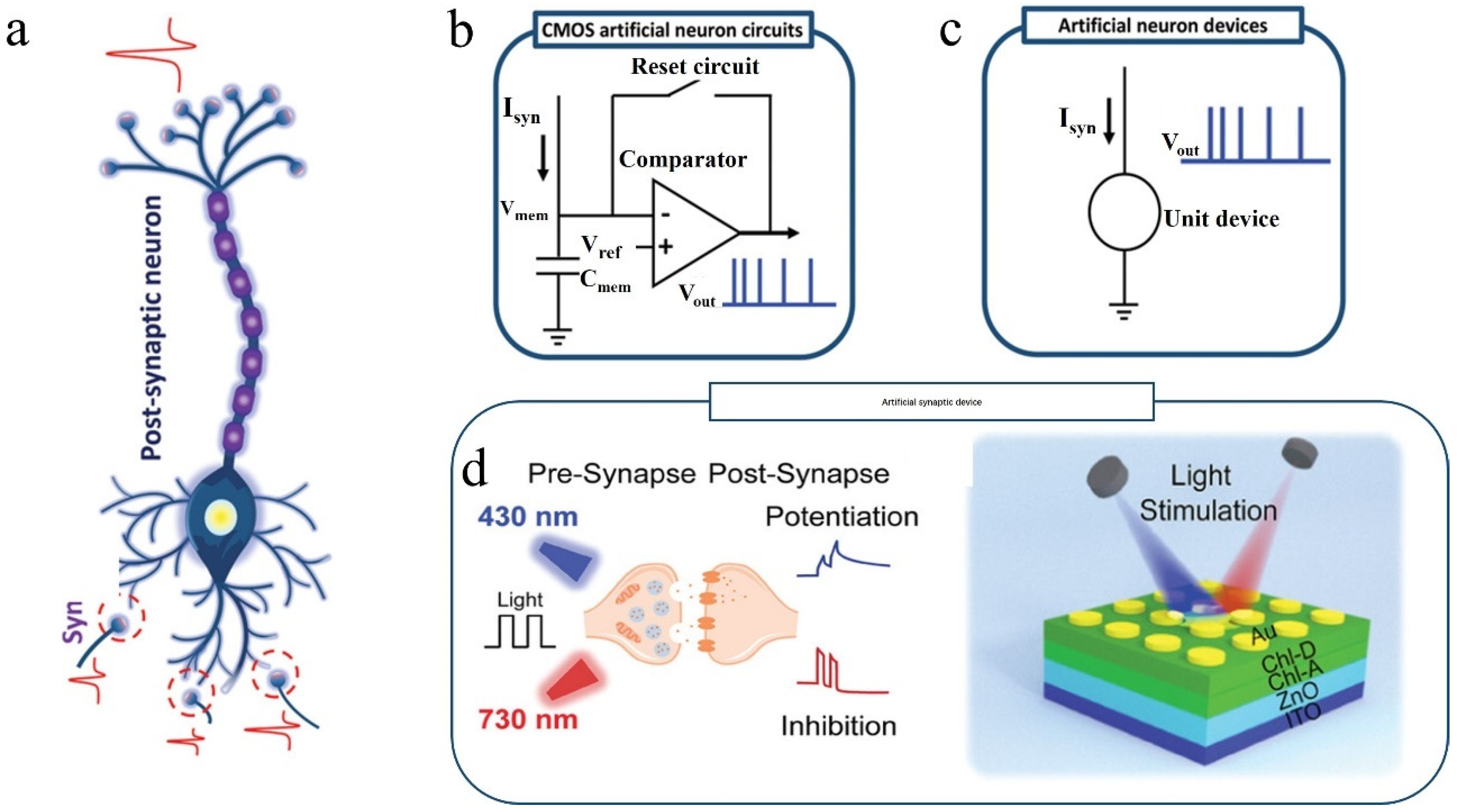
2. Basic Synaptic Functions and Device Simulation Methods
2.1. Postsynaptic Current Responses
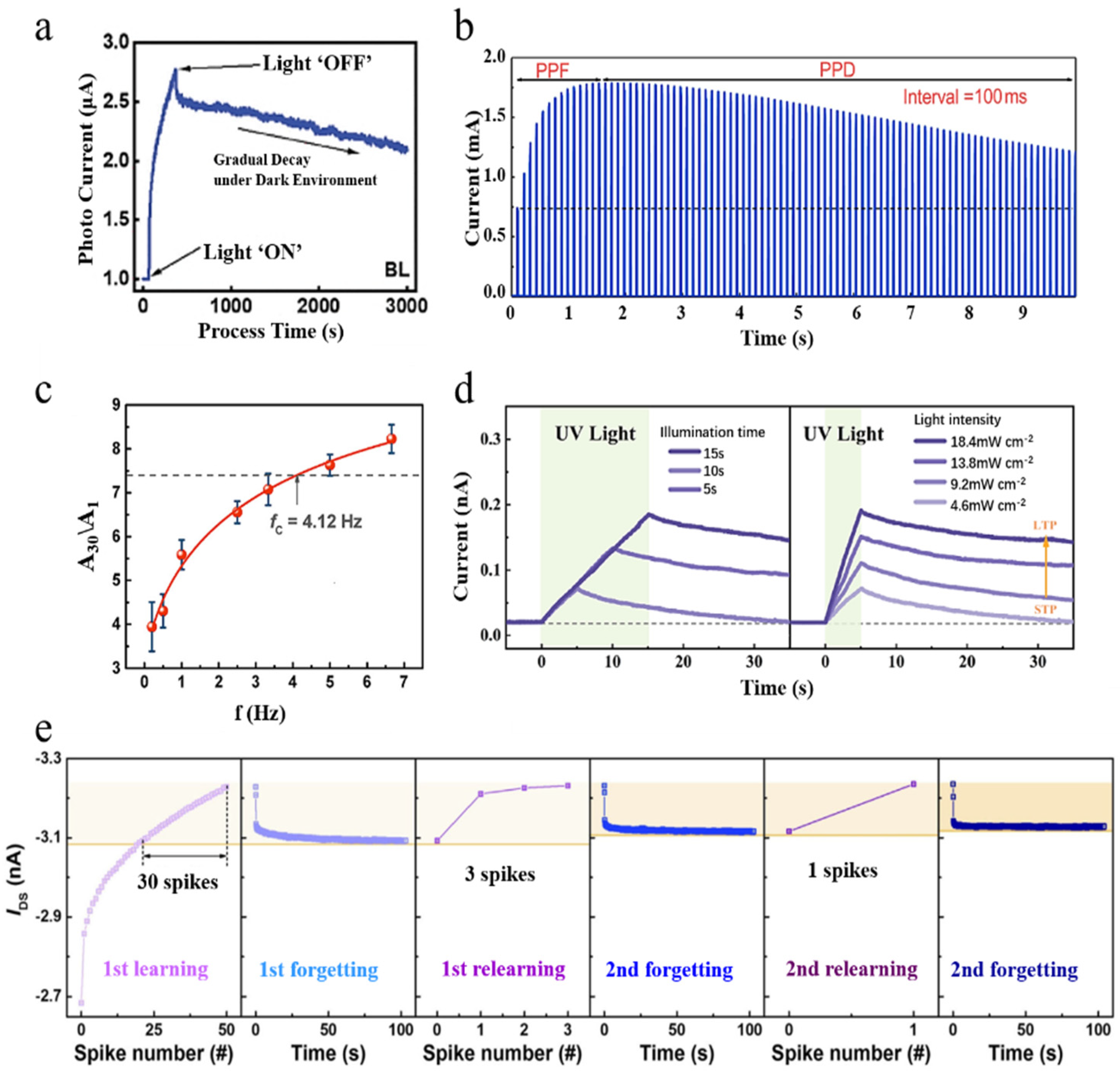
2.2. STP and LTP Behaviors
2.3. Human Memory Behaviors
3. Optoelectronic Artificial Synapse
3.1. The Formation and Breakage of Conductive Filaments
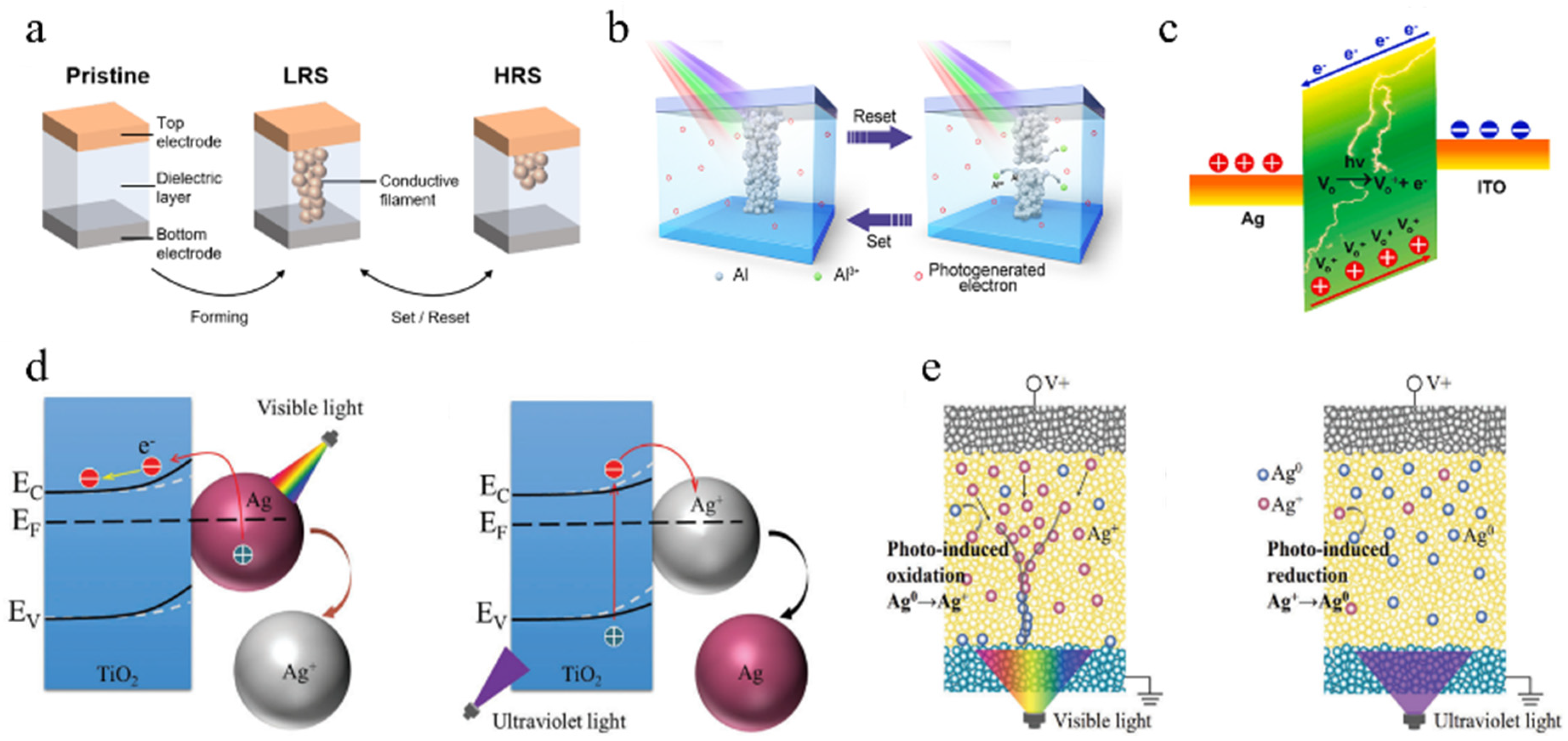
3.2. Barrier Type and Depletion Layer Type
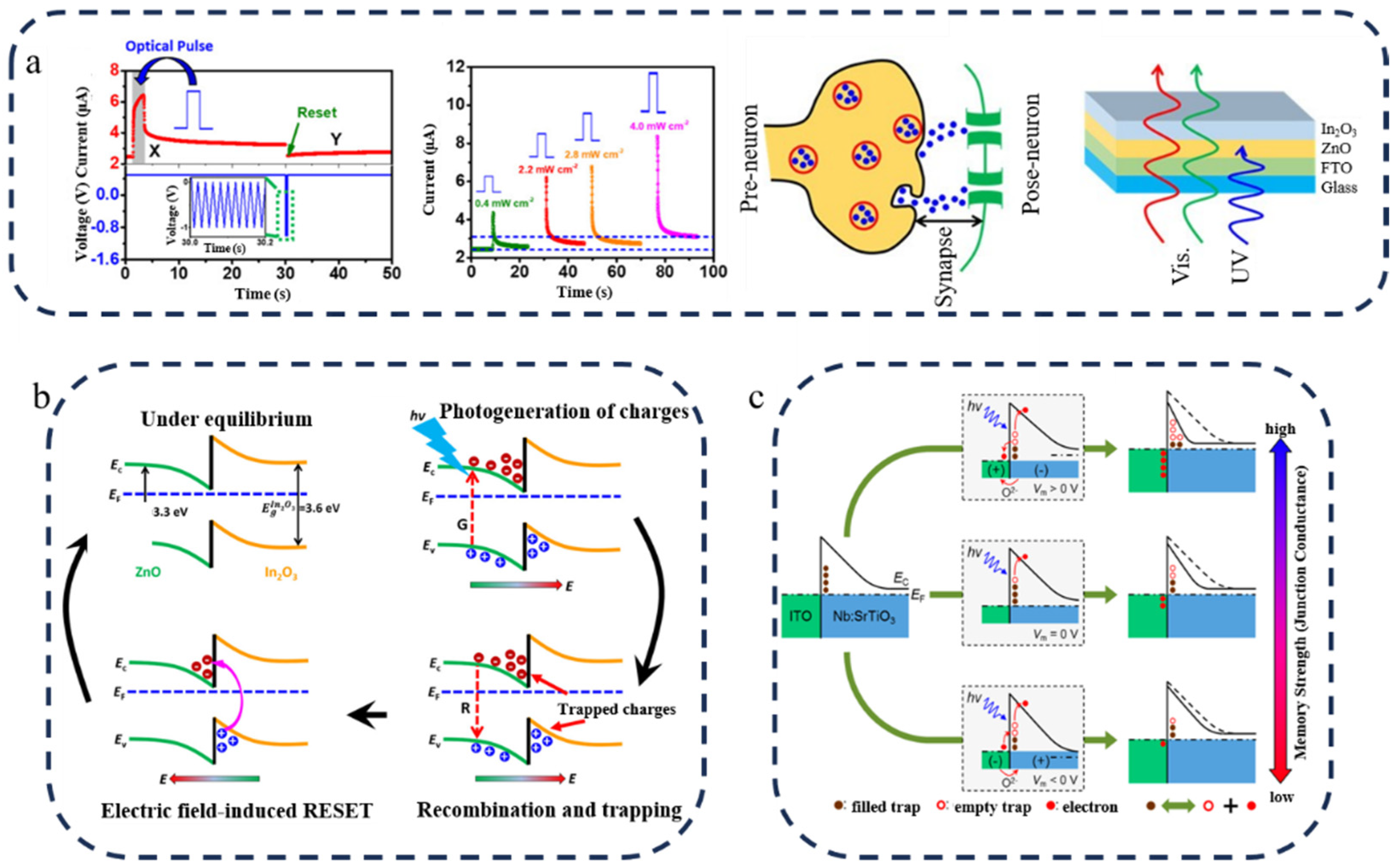
3.3. Three-Terminal Optoelectronic Transistor
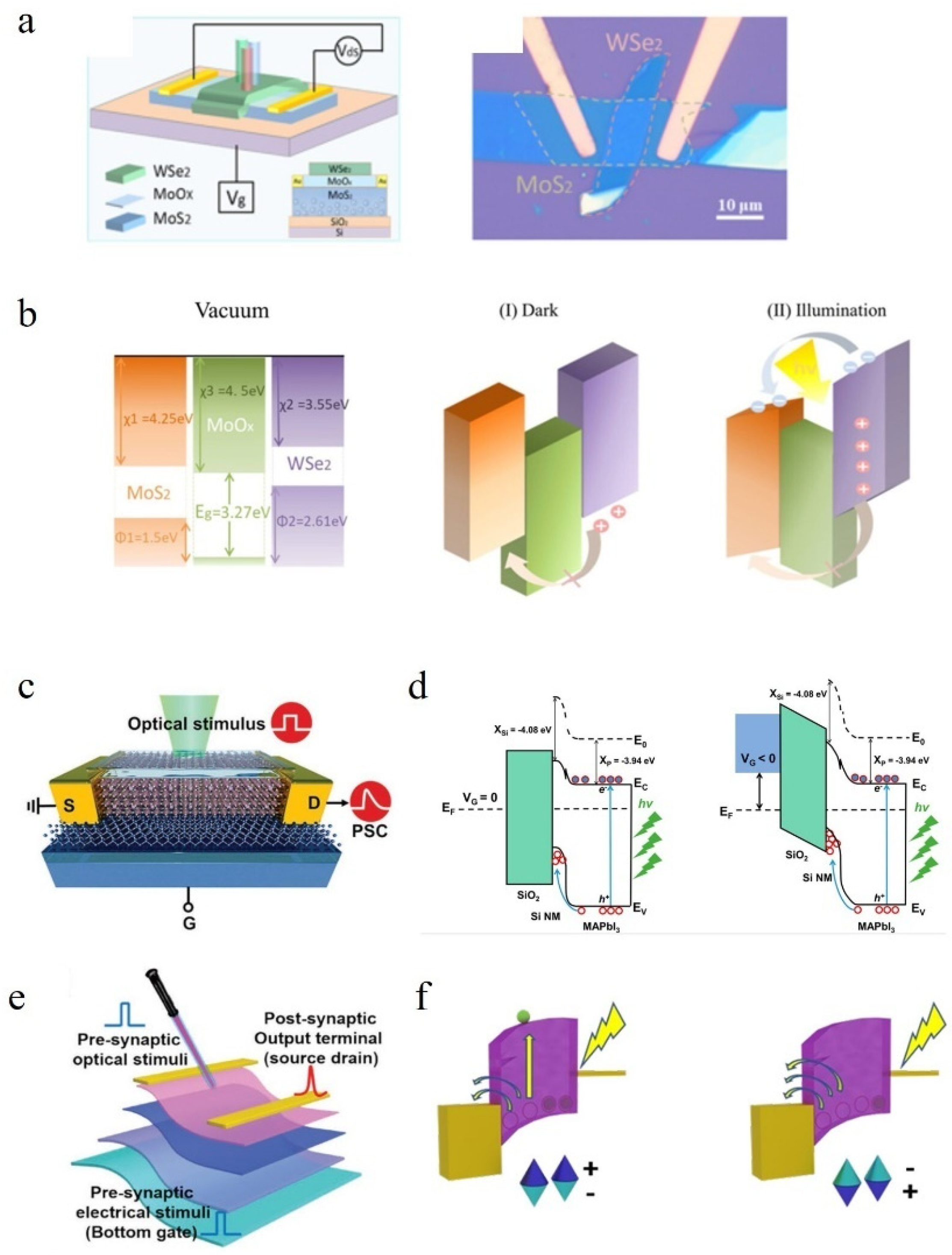
4. All-Optical Artificial Synapse
4.1. Barrier Type
4.1.1. PN Heterojunctions
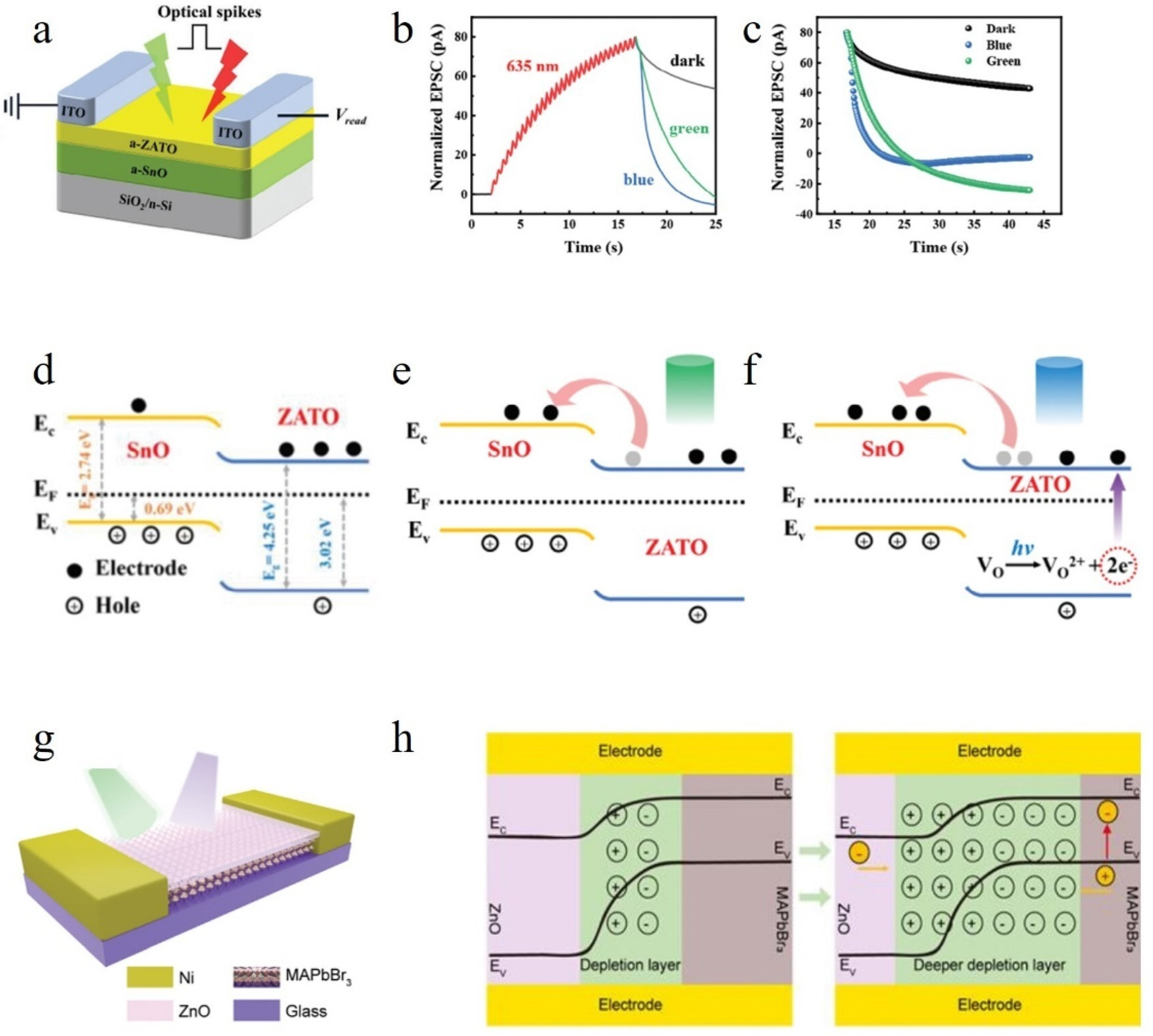
4.1.2. Multi-Layer Heterojunctions
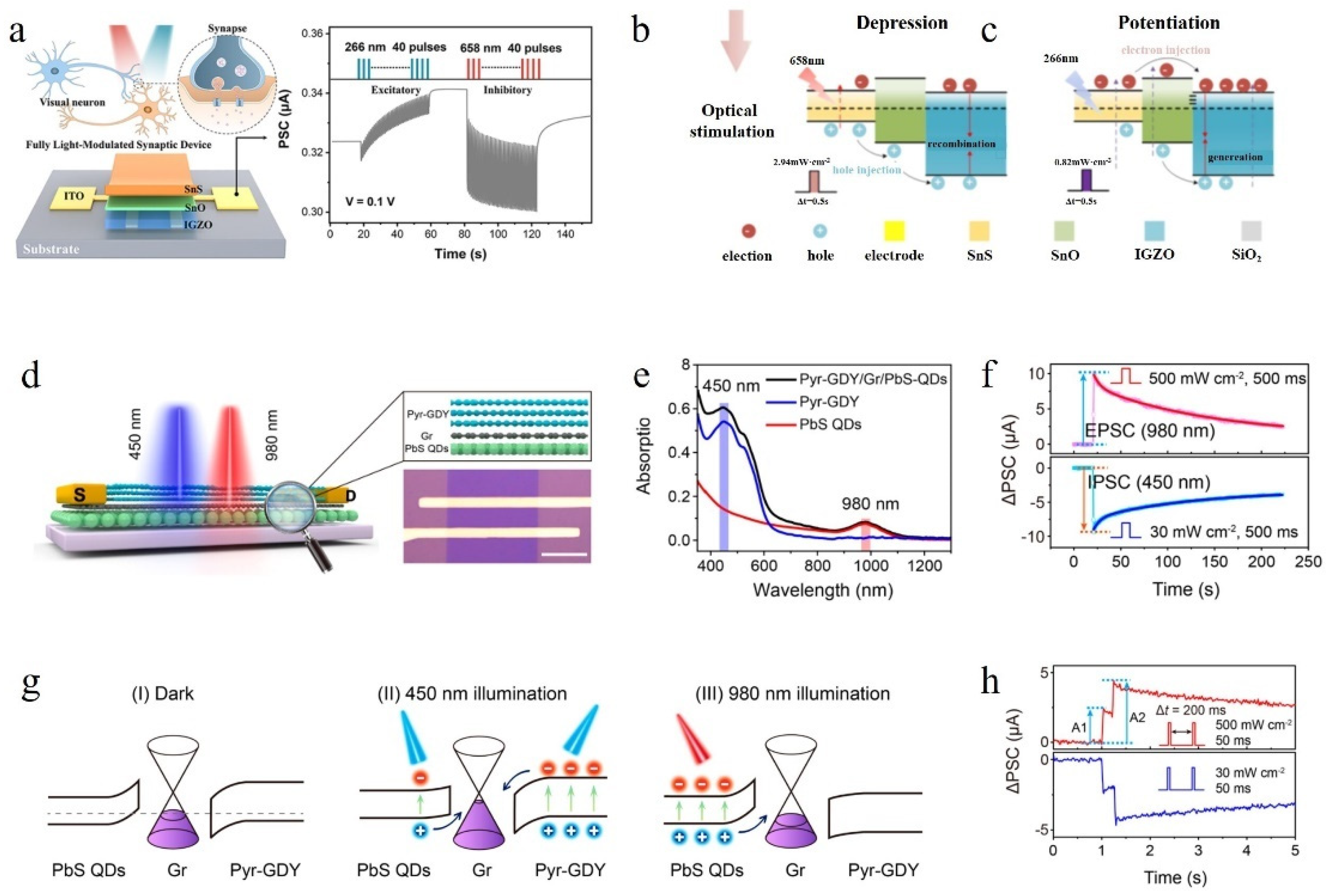
4.1.3. Schottky Barrier Type
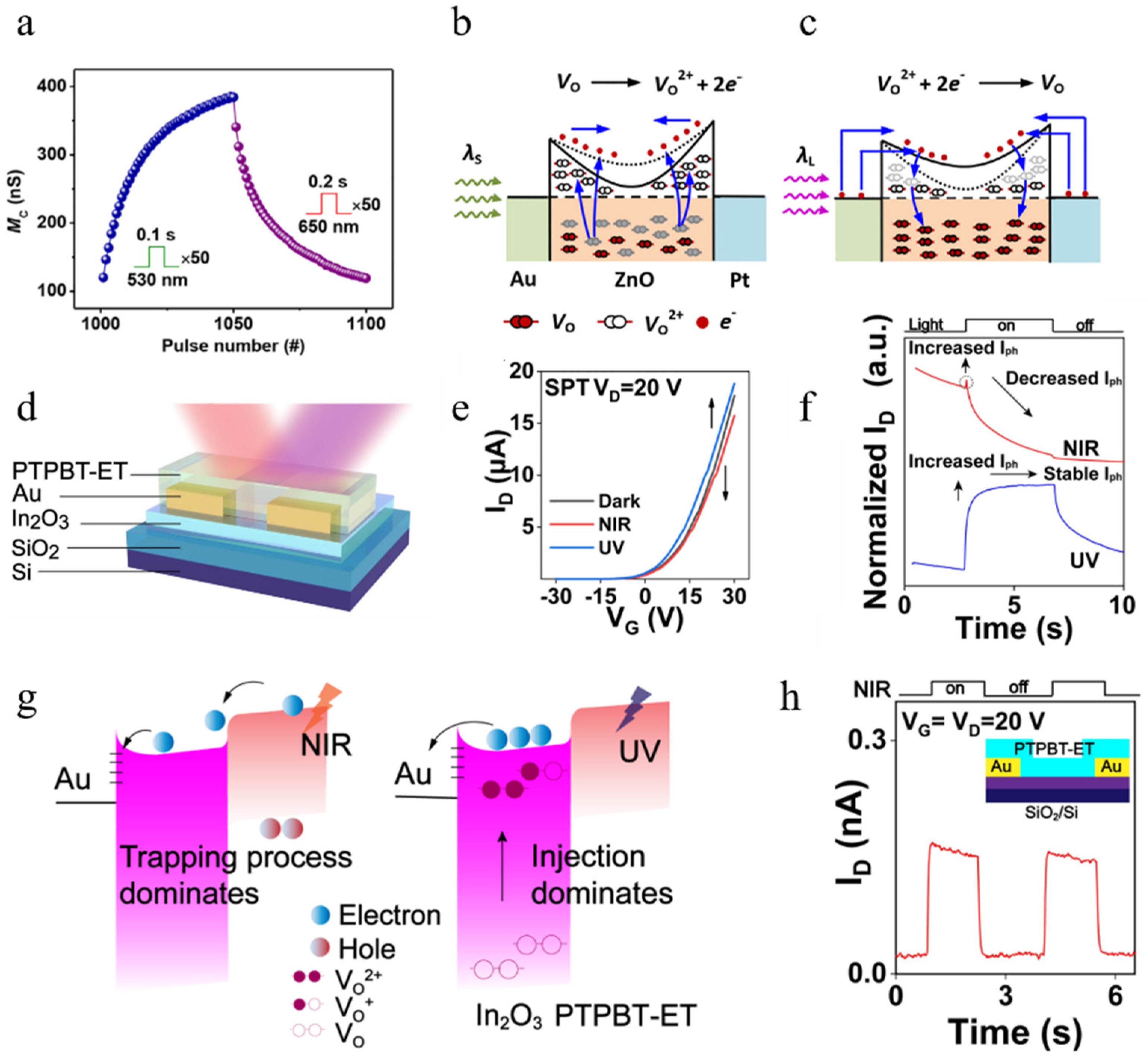
4.1.4. Other Types
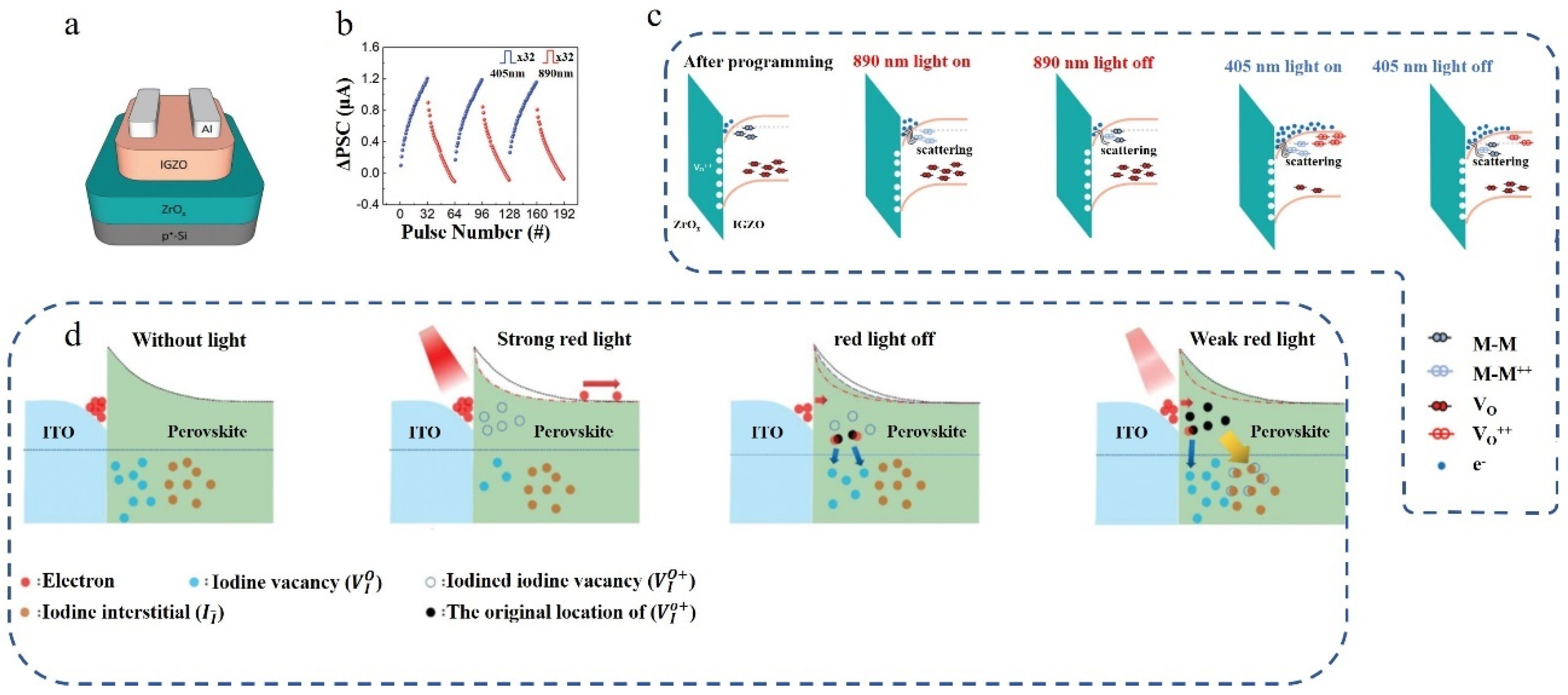
4.2. Redox Type
4.2.1. Metal Redox Type
4.2.2. Gas Adsorption Analysis Type

5. The Material Used to Make Artificial Synapses
5.1. The Materials for Manufacturing Optoelectronic Artificial Synapses
5.2. The Materials for Manufacturing All-Optical Control Devices
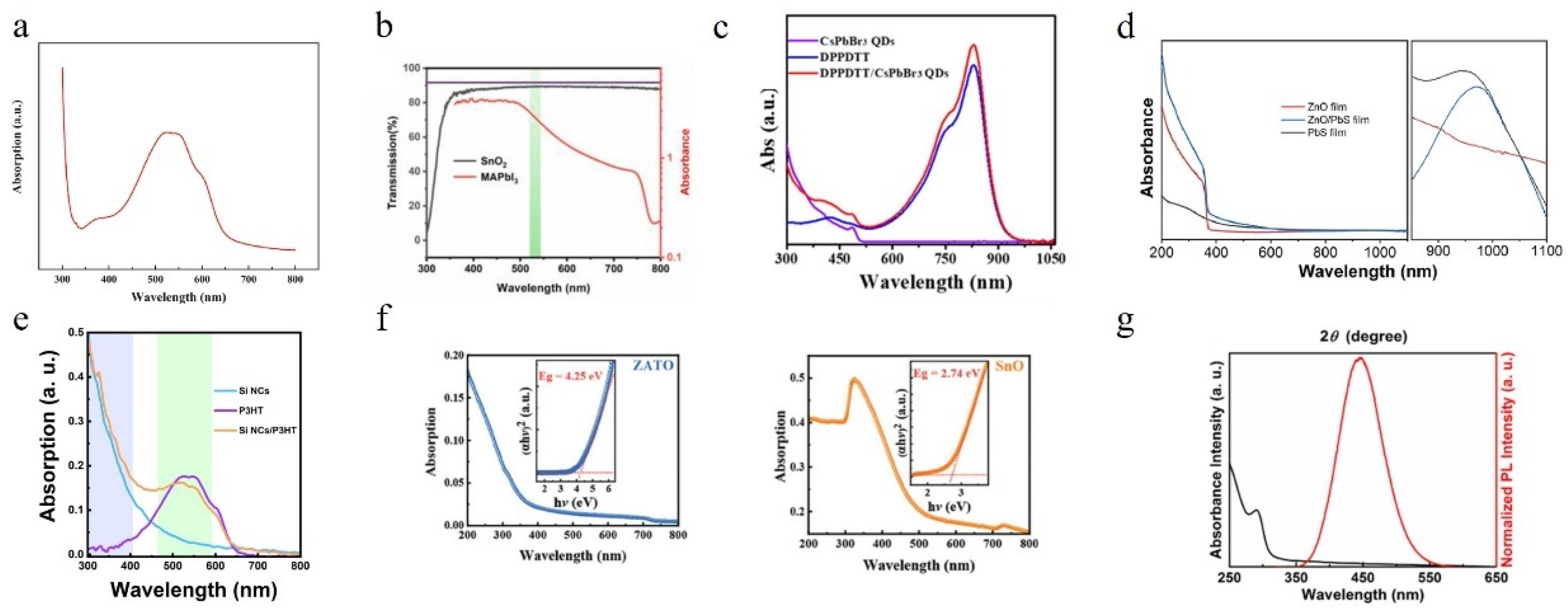
6. Applications of Optoelectronic All-Optical Synaptic Devices
6.1. Brain-like Function Simulation
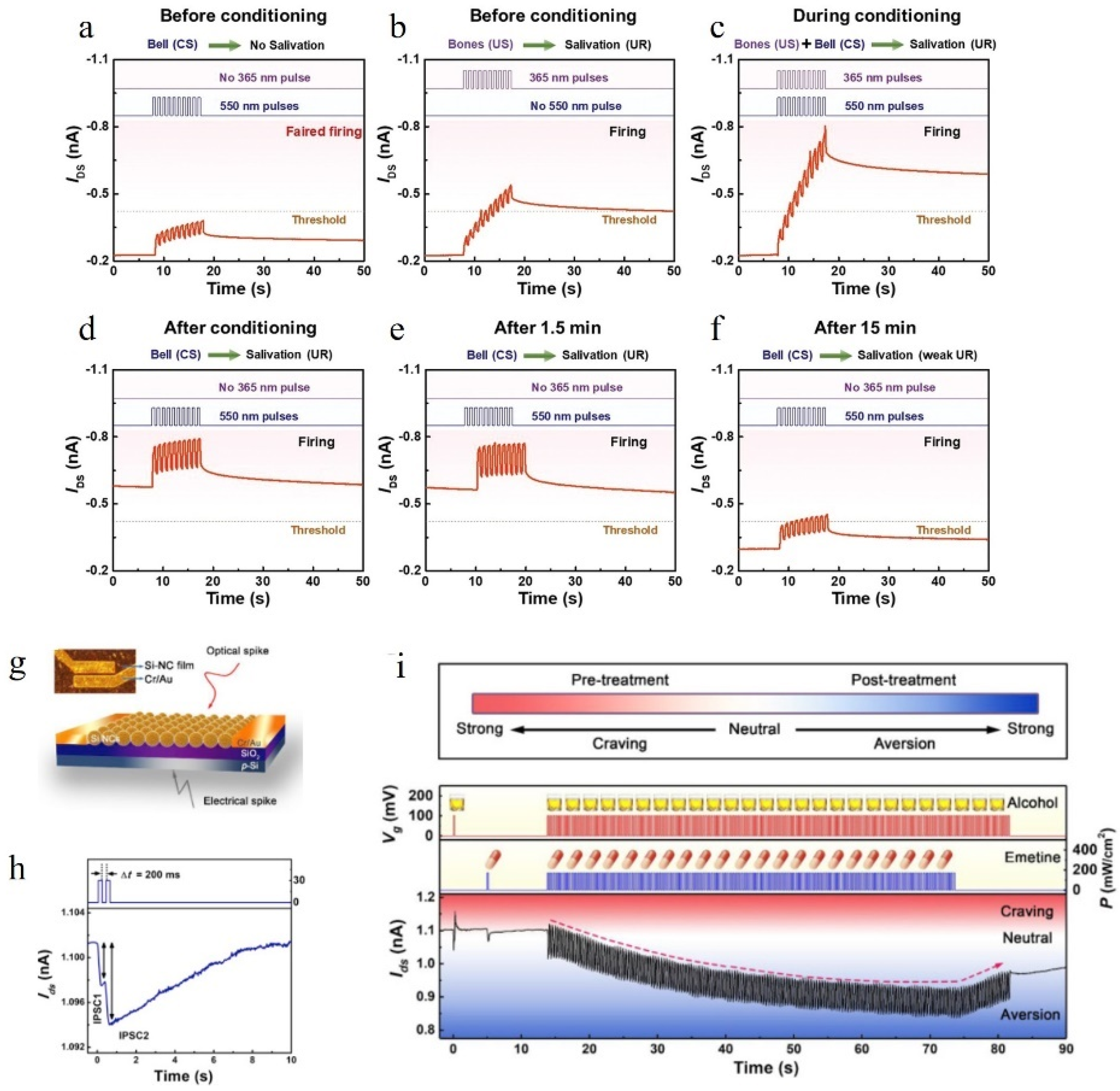
6.2. Logical Operations and Arithmetic Operations
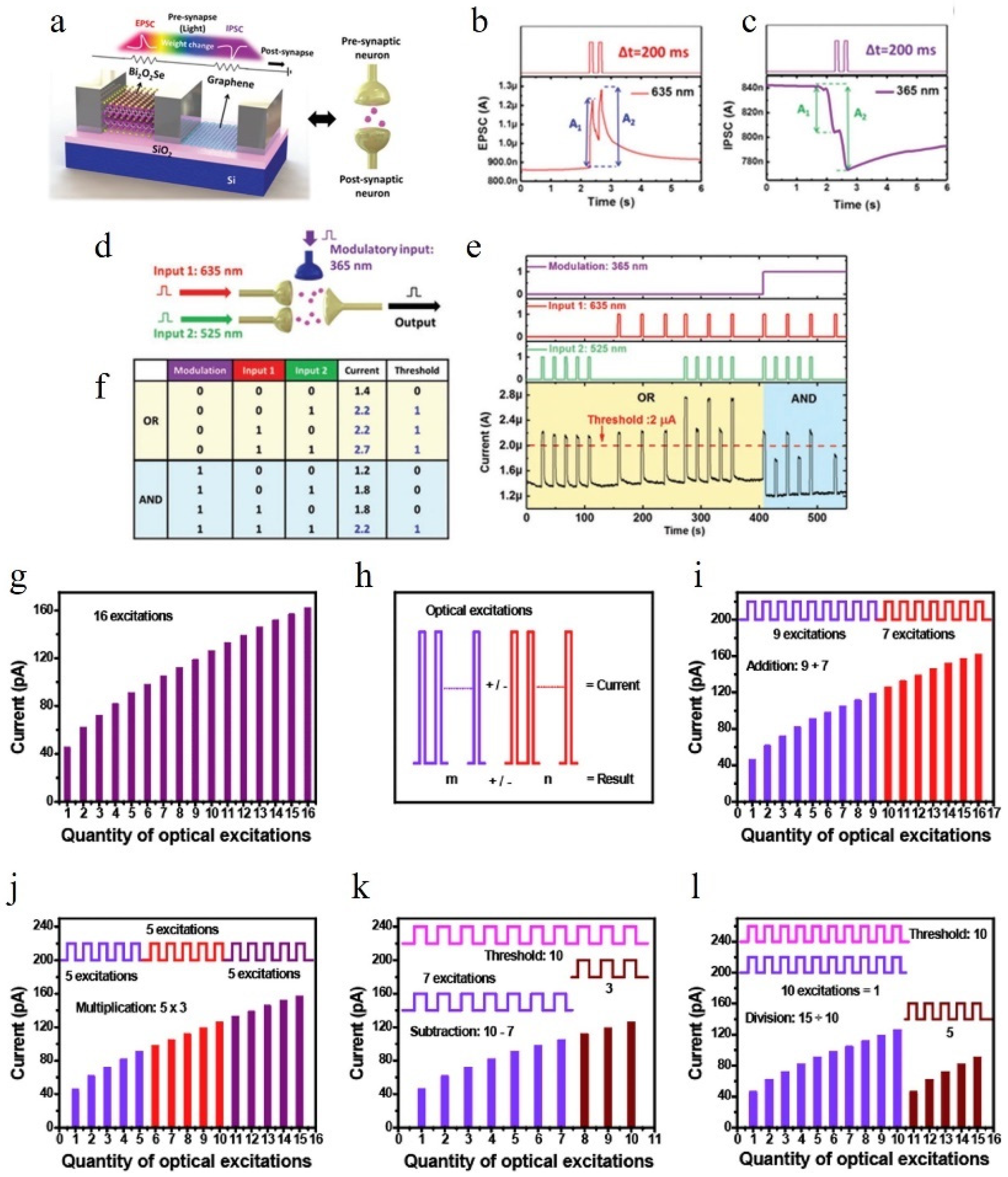
6.3. Visual Perception System
6.3.1. Image Preprocessing
6.3.2. Environmental Adaptability
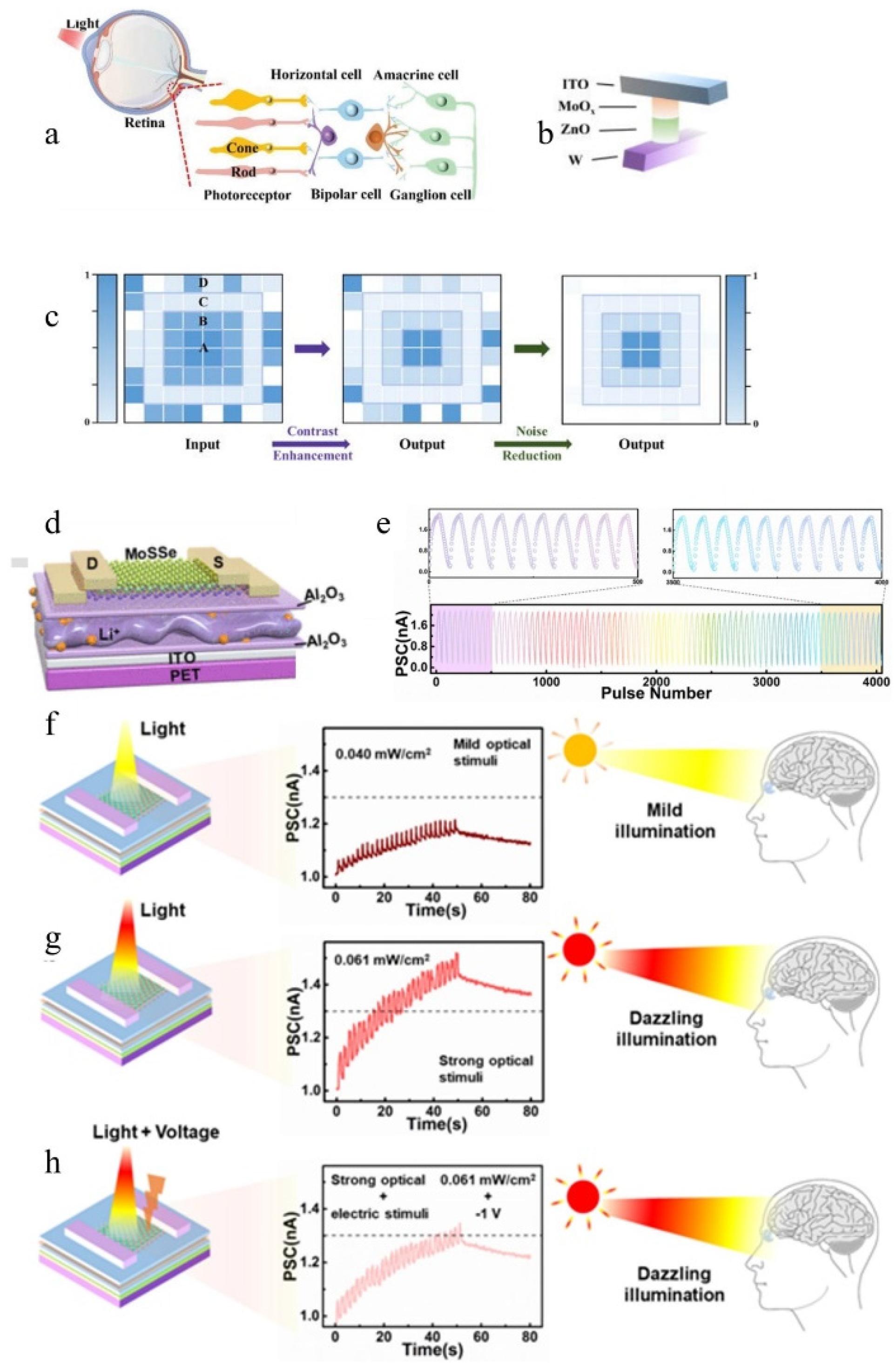
6.4. Artificial Neural Network
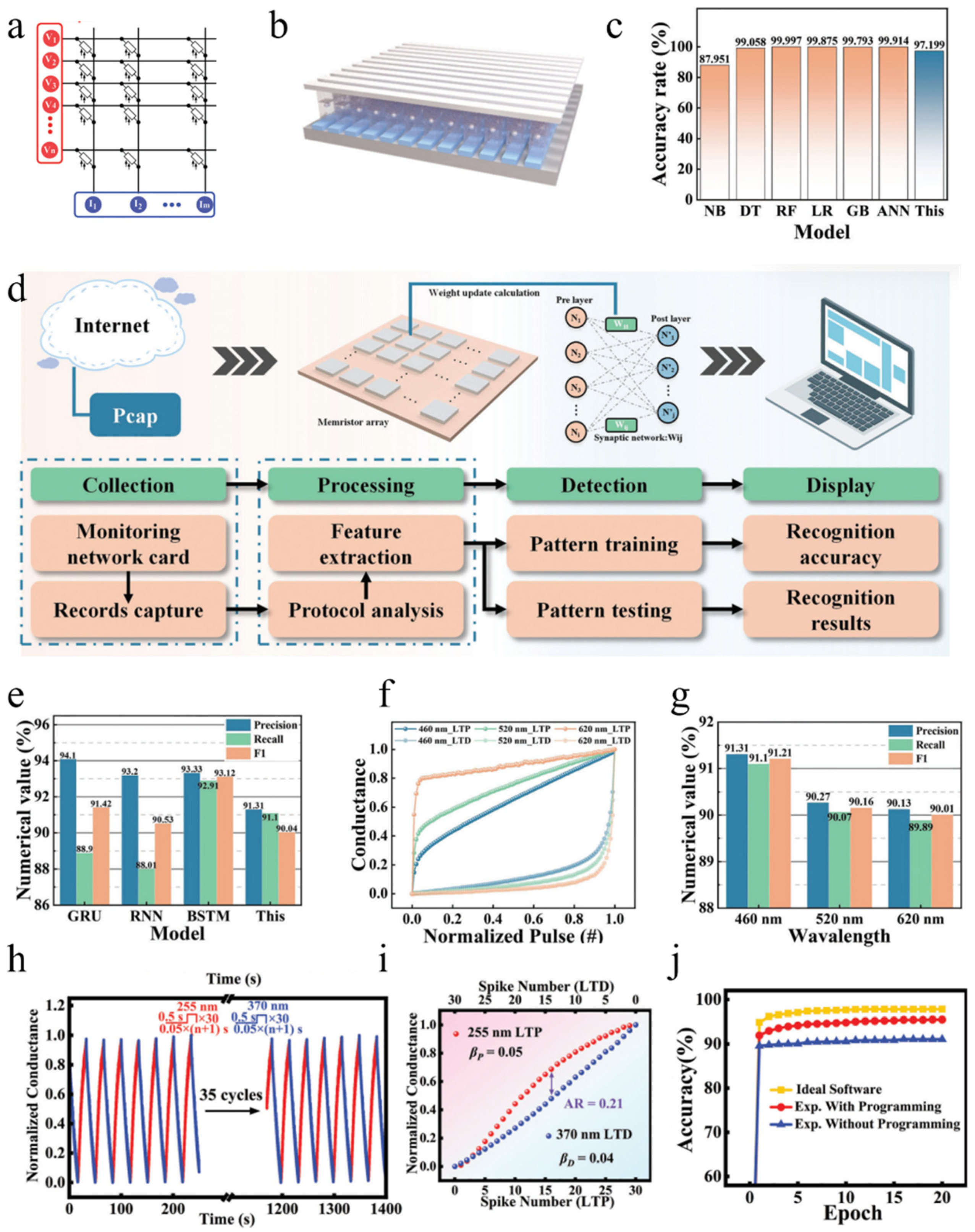
6.4.1. Low-Power Neural Networks
6.4.2. Improved Accuracy through Varying the Light Stimulus
7. Summary and Outlook
- (I)
- Synapses represent only a fraction of nerve cells. Presently, research is solely focused on simulating synapses rather than the entire neuron. Other components of nerve cells, such as axons and dendrites, also possess significant research value. Dendrites receive information from other cells, then transmit the information to the axon, which in turn connects with dendrites of other neurons to pass on the information. In previous discussions, the focus has been on studying the properties of individual synapses. In subsequent research, integrating multiple neurons to perform more complex tasks, especially simulating the process of information transmission in the human brain, will become a research hotspot.
- (II)
- In the post-Moore’s Law era, there has been a remarkable surge in transistor density on chips and processor operating frequency, resulting in a substantial increase in power consumption. Although artificial synapses hold promise for addressing this challenge, their complete potential remains largely unexplored. RRAM (resistance random access memory) devices can mimic the function of biological synapses through their electrical properties. The relevant literature indicates that RRAM’s theoretical minimum cell area can reach at least 4F2, where F represents the feature size of a given process [157]; however, few authors have addressed the issue of device size optimization in their papers. On the other hand, regarding the problem of applying the stimulus, take the device shown in Figure 10a as an example. In this paper, the authors apply SET light and RESET light for up to 1000 s to make the device conductance rise and fall. According to “Work is equal to power times time”, the electrical work consumed will increase with time. Even if the PSC power is not high, it will cause unnecessary energy consumption. In addition, the energy of the light source will also be consumed in this process. Moreover, the exposure time of 1000 s also proves that the device is not suitable for the situation where fast reaction is required. One possible approach could involve reducing device size and excitation light width; however, these strategies impose greater demands on manufacturing processes and synaptic performance [33].
- (III)
- In practical situations, the tasks that can be accomplished by a single synapse are very limited, so integration will become a hot topic in future research. The cooperation of multiple devices will result in better system performance. However, dual-terminal devices often face the obstacle of crosstalk between adjacent devices due to their higher integration density. On the other hand, three-terminal devices can handle more complex tasks due to gate control. Therefore, trade-offs need to be made based on applications in practical situations. Taking the crossbar structure shown in Figure 15a as an example, devices are placed at the intersection of both the transverse and longitudinal crossbars. If you only want to use the crossbar structure to complete some computational tasks (such as matrix multiplication operation), then you can use two-terminal devices to form the crossbar structure. At present, there have been reports in this aspect [158]. In addition, there are also reports that the combination of two-terminal and three-terminal devices is used to form a one-transistor-one-memristor (1T1R) structure. Yao et al. built a complete five-layer convolutional neural networks for digital image recognition based on the crossbar structure of 1T1R, with a training accuracy of 96.19% and a 3-fold reduction in latency [159].
- (IV)
- Durability and manufacturability are crucial for a device to be manufactured as a product. Durability and manufacturability encompass three aspects. Firstly, the device’s performance must remain stable after undergoing numerous SET and RESET processes. Secondly, it should retain its properties over an extended period of time, regardless of different environmental conditions. Thirdly, the manufacturing process must be capable of consistently producing devices with uniform properties. Achieving durability poses a significant challenge. If we define the change in conductance (or PSC) from the initial value to the maximum value and back to the initial value as one cycle, then it can be observed that the device depicted in Figure 9a has undergone three cycles. As illustrated in Figure 9b, the PSC–pulse number curves obtained during these three cycles exhibit a high degree of similarity, indicating an ideal scenario. Similar experiments have been reported in multiple articles [58,90]. A perfect device is one for which, no matter how many cycles it has gone through, the PSC–pulse number curve is basically overlapping, which has been reported in many articles at present. However, the tremendous success of CMOS devices has inspired us to conduct the following experiments: ① Whether the properties of the devices degrade significantly after long-term placement (especially in extreme environments such as humidity and high temperature). ② How much deviation is there in devices produced with the same process? This experiment is very important because it determines whether a standard manufacturing process can be developed.
- (V)
- Artificial synapses are an interdisciplinary field that requires knowledge from physics, chemistry, and biology. Basic science serves as the foundation for all sciences; therefore, researchers working on optoelectronics or all-optical studies should always keep track of advancements in these three domains. Artificial synapses essentially mimic biological systems where biology provides theoretical foundations, while chemistry and physics offer materials for implementation and new principles.
Funding
Conflicts of Interest
References
- Holcomb, S.D.; Porter, W.K.; Ault, S.V.; Mao, G.; Wang, J. Overview on deepmind and its alphago zero ai. In Proceedings of the 2018 International Conference on Big Data and Education, Seattle, WA, USA, 10–13 December 2018; pp. 67–71. [Google Scholar]
- Kimovski, D.; Saurabh, N.; Jansen, M.; Aral, A.; Al-Dulaimy, A.; Bondi, A.B.; Galletta, A.; Papadopoulos, A.V.; Iosup, A.; Prodan, R. Beyond von neumann in the computing continuum: Architectures, applications, and future directions. IEEE Internet Comput. 2023, 28, 6–16. [Google Scholar] [CrossRef]
- Jaiswal, A.; Chakraborty, I.; Agrawal, A.; Roy, K. 8T SRAM cell as a multibit dot-product engine for beyond von Neumann computing. IEEE Trans. Very Large Scale Integr. (VLSI) Syst. 2019, 27, 2556–2567. [Google Scholar] [CrossRef]
- Zou, X.; Xu, S.; Chen, X.; Yan, L.; Han, Y. Breaking the von Neumann bottleneck: Architecture-level processing-in-memory technology. Sci. China Inf. Sci. 2021, 64, 160404. [Google Scholar] [CrossRef]
- Upadhyay, N.K.; Joshi, S.; Yang, J. Synaptic electronics and neuromorphic computing. Sci. China Inf. Sci. 2016, 59, 1–26. [Google Scholar] [CrossRef]
- Conrad, M.; Engl, E.; Jolivet, R.B. Energy use constrains brain information processing. In Proceedings of the 2017 IEEE International Electron Devices Meeting (IEDM), San Francisco, CA, USA, 2–6 December 2017; pp. 11.13.11–11.13.13. [Google Scholar]
- Attwell, D.; Laughlin, S.B. An energy budget for signaling in the grey matter of the brain. J. Cereb. Blood Flow Metab. 2001, 21, 1133–1145. [Google Scholar] [CrossRef]
- Russo, N.; Madsen, T.; Nikolic, K. An Implementation of Communication, Computing and Control Tasks for Neuromorphic Robotics on Conventional Low-Power CPU Hardware. Electronics 2024, 13, 3448. [Google Scholar] [CrossRef]
- Kuzum, D.; Yu, S.; Wong, H. Synaptic electronics: Materials, devices and applications. Nanotechnology 2013, 24, 382001. [Google Scholar] [CrossRef]
- Gao, S.; Zhou, M.; Wang, Y.; Cheng, J.; Yachi, H.; Wang, J. Dendritic neuron model with effective learning algorithms for classification, approximation, and prediction. IEEE Trans. Neural Netw. Learn. Syst. 2018, 30, 601–614. [Google Scholar] [CrossRef]
- Jo, Y.; Woo, D.Y.; Noh, G.; Park, E.; Kim, M.J.; Sung, Y.W.; Lee, D.K.; Park, J.; Kim, J.; Jeong, Y. Hardware Implementation of Network Connectivity Relationships Using 2D hBN-Based Artificial Neuron and Synaptic Devices. Adv. Funct. Mater. 2024, 34, 2309058. [Google Scholar] [CrossRef]
- Han, J.K.; Yun, S.Y.; Lee, S.W.; Yu, J.M.; Choi, Y.K. A review of artificial spiking neuron devices for neural processing and sensing. Adv. Funct. Mater. 2022, 32, 2204102. [Google Scholar] [CrossRef]
- Lee, G.; Baek, J.H.; Ren, F.; Pearton, S.J.; Lee, G.H.; Kim, J.J. Artificial neuron and synapse devices based on 2D materials. Small 2021, 17, 2100640. [Google Scholar] [CrossRef] [PubMed]
- Yuan, J.; Wu, C.; Wang, S.; Wu, F.; Tan, C.K.; Guo, D. Enhancing plasticity in optoelectronic artificial synapses: A pathway to efficient neuromorphic computing. Appl. Phys. Lett. 2024, 124, 021101. [Google Scholar] [CrossRef]
- Coste, P.; Kovács, I.; Neag, M.; Grăjdeanu, A.-T.; Ionescu, V.-A.; Ţopa, M.D. Type-II compensation for automotive buck converters implemented by fully integrated capacitor multiplier. IEEE Access 2022, 10, 37678–37688. [Google Scholar] [CrossRef]
- Liu, H.; Qin, Y.; Chen, H.Y.; Wu, J.; Ma, J.; Du, Z.; Wang, N.; Zou, J.; Lin, S.; Zhang, X. Artificial neuronal devices based on emerging materials: Neuronal dynamics and applications. Adv. Mater. 2023, 35, 2205047. [Google Scholar] [CrossRef]
- Merolla, P.A.; Arthur, J.V.; Alvarez-Icaza, R.; Cassidy, A.S.; Sawada, J.; Akopyan, F.; Jackson, B.L.; Imam, N.; Guo, C.; Nakamura, Y.J.S. A million spiking-neuron integrated circuit with a scalable communication network and interface. Science 2014, 345, 668–673. [Google Scholar] [CrossRef]
- Davies, M.; Srinivasa, N.; Lin, T.-H.; Chinya, G.; Cao, Y.; Choday, S.H.; Dimou, G.; Joshi, P.; Imam, N.; Jain, S. Loihi: A neuromorphic manycore processor with on-chip learning. IEEE Micro 2018, 38, 82–99. [Google Scholar] [CrossRef]
- Song, S.; Kim, M.; Yoo, G.; Kwon, S.-M.; Heo, J.-S.; Park, S.K.; Kim, Y.-H. Solution-processed oxide semiconductor-based artificial optoelectronic synapse array for spatiotemporal synaptic integration. J. Alloys Compd. 2021, 857, 158027. [Google Scholar] [CrossRef]
- Zhao, P.; Ji, R.; Lao, J.; Xu, W.; Jiang, C.; Luo, C.; Lin, H.; Peng, H.; Duan, C. Two-terminal organic optoelectronic synapse based on poly (3-hexylthiophene) for neuromorphic computing. Org. Electron. 2022, 100, 106390. [Google Scholar] [CrossRef]
- Liu, Q.; Yin, L.; Zhao, C.; Wang, J.; Wu, Z.; Lei, H.; Liu, Y.; Tian, B.; Zhang, Z.; Zhao, Z. Hybrid mixed-dimensional perovskite/metal-oxide heterojunction for all-in-one opto-electric artificial synapse and retinal-neuromorphic system. Nano Energy 2022, 102, 107686. [Google Scholar] [CrossRef]
- Huang, W.; Hang, P.; Xia, X.; Li, B.; Li, B.; Kan, C.; Zhang, H.; Zhu, C.; Wang, C.; Zhu, X. Two-terminal self-rectifying optoelectronic synaptic devices with largest-dynamic-range updates. Appl. Mater. Today 2023, 30, 101728. [Google Scholar] [CrossRef]
- Liu, L.; Cheng, Z.; Jiang, B.; Liu, Y.; Zhang, Y.; Yang, F.; Wang, J.; Yu, X.-F.; Chu, P.K.; Ye, C.J.; et al. Optoelectronic artificial synapses based on two-dimensional transitional-metal trichalcogenide. ACS Appl. Mater. Interfaces 2021, 13, 30797–30805. [Google Scholar] [CrossRef] [PubMed]
- Gao, S.; Liu, G.; Yang, H.; Hu, C.; Chen, Q.; Gong, G.; Xue, W.; Yi, X.; Shang, J.; Li, R.-W. An oxide Schottky junction artificial optoelectronic synapse. ACS Nano 2019, 13, 2634–2642. [Google Scholar] [CrossRef] [PubMed]
- Luo, Z.-D.; Xia, X.; Yang, M.-M.; Wilson, N.R.; Gruverman, A.; Alexe, M. Artificial optoelectronic synapses based on ferroelectric field-effect enabled 2D transition metal dichalcogenide memristive transistors. ACS Nano 2019, 14, 746–754. [Google Scholar] [CrossRef] [PubMed]
- Ismail, M.; Kim, D.; Lim, E.; Rasheed, M.; Mahata, C.; Seo, Y.; Kim, S. Exploration of Analog Synaptic Plasticity and Convolutional Neural Network Simulation in Bilayer TiO x N y/SnO x Memristor for Neuromorphic Systems. ACS Mater. Lett. 2024, 6, 3514–3522. [Google Scholar] [CrossRef]
- Qian, Y.; Li, J.; Li, W.; Hou, C.-H.; Feng, Z.; Shi, W.; Yi, M. High synaptic plasticity enabled by controlled ion migration in organic heterojunction memristors. J. Mater. Chem. C 2024, 12, 9669–9676. [Google Scholar] [CrossRef]
- Hou, Y.-X.; Li, Y.; Zhang, Z.-C.; Li, J.-Q.; Qi, D.-H.; Chen, X.-D.; Wang, J.-J.; Yao, B.-W.; Yu, M.-X.; Lu, T.-B.J. Large-scale and flexible optical synapses for neuromorphic computing and integrated visible information sensing memory processing. ACS Nano 2020, 15, 1497–1508. [Google Scholar] [CrossRef]
- Ismail, M.; Rasheed, M.; Mahata, C.; Kang, M.; Kim, S. Nano-crystalline ZnO memristor for neuromorphic computing: Resistive switching and conductance modulation. J. Alloys Compd. 2023, 960, 170846. [Google Scholar] [CrossRef]
- Ismail, M.; Mahata, C.; Kang, M.; Kim, S. Exploring conductance modulation and implementation of convolutional neural network in Pt/ZnO/Al2O3/TaN memristors for brain-inspired computing. Ceram. Int. 2023, 49, 19032–19042. [Google Scholar] [CrossRef]
- Lu, K.; Li, X.; Sun, Q.; Pang, X.; Chen, J.; Minari, T.; Liu, X.; Song, Y. Solution-processed electronics for artificial synapses. Mater. Horiz. 2021, 8, 447–470. [Google Scholar] [CrossRef]
- Meng, J.-L.; Wang, T.-Y.; He, Z.-Y.; Chen, L.; Zhu, H.; Ji, L.; Sun, Q.-Q.; Ding, S.-J.; Bao, W.-Z.; Zhou, P.J. Flexible boron nitride-based memristor for in situ digital and analogue neuromorphic computing applications. Mater. Horiz. 2021, 8, 538–546. [Google Scholar] [CrossRef]
- Wang, J.; Ilyas, N.; Ren, Y.; Ji, Y.; Li, S.; Li, C.; Liu, F.; Gu, D.; Ang, K. Technology and integration roadmap for optoelectronic memristor. Adv. Mater. 2024, 36, 2307393. [Google Scholar] [CrossRef] [PubMed]
- Rehman, S.; Khan, M.F.; Rahmani, M.K.; Kim, H.; Patil, H.; Khan, S.A.; Kang, M.H.; Kim, D. Neuro-transistor based on uv-treated charge trapping in mote2 for artificial synaptic features. Nanomaterials 2020, 10, 2326. [Google Scholar] [CrossRef] [PubMed]
- Desai, T.R.; Dongale, T.D.; Patil, S.R.; Tiwari, A.P.; Pawar, P.K.; Kamat, R.K.; Kim, T. Synaptic learning functionalities of inverse biomemristive device based on trypsin for artificial intelligence application. J. Mater. Res. Technol. 2021, 11, 1100–1110. [Google Scholar] [CrossRef]
- Kwon, S.M.; Cho, S.W.; Kim, M.; Heo, J.S.; Kim, Y.H.; Park, S.K. Environment-adaptable artificial visual perception behaviors using a light-adjustable optoelectronic neuromorphic device array. Adv. Mater. 2019, 31, 1906433. [Google Scholar] [CrossRef] [PubMed]
- Pereira, M.E.; Martins, R.; Fortunato, E.; Barquinha, P.; Kiazadeh, A. Recent progress in optoelectronic memristors for neuromorphic and in-memory computation. Neuromorphic Comput. Eng. 2023, 3, 022002. [Google Scholar] [CrossRef]
- Yu, S. Neuro-inspired computing with emerging nonvolatile memorys. Proc. IEEE 2018, 106, 260–285. [Google Scholar] [CrossRef]
- Milo, V.; Zambelli, C.; Olivo, P.; Pérez, E.; K Mahadevaiah, M.; G Ossorio, O.; Wenger, C.; Ielmini, D. Multilevel HfO2-based RRAM devices for low-power neuromorphic networks. APL Mater. 2019, 7, 081120. [Google Scholar] [CrossRef]
- Guo, Z.; Liu, G.; Sun, Y.; Zhang, Y.; Zhao, J.; Liu, P.; Wang, H.; Zhou, Z.; Zhao, Z.; Jia, X.J. High-performance neuromorphic computing and logic operation based on a self-assembled vertically aligned nanocomposite SrTiO3: MgO film memristor. ACS Nano 2023, 17, 21518–21530. [Google Scholar] [CrossRef]
- Zhao, J.; Zhou, Z.; Zhang, Y.; Wang, J.; Zhang, L.; Li, X.; Zhao, M.; Wang, H.; Pei, Y.; Zhao, Q.J. An electronic synapse memristor device with conductance linearity using quantized conduction for neuroinspired computing. J. Mater. Chem. C 2019, 7, 1298–1306. [Google Scholar] [CrossRef]
- Jiang, J.; Shan, X.; Xu, J.; Sun, Y.; Xiang, T.F.; Li, A.; Sasaki, S.i.; Tamiaki, H.; Wang, Z.; Wang, X. Retina-Like Chlorophyll Heterojunction-Based Optoelectronic Memristor with All-Optically Modulated Synaptic Plasticity Enabling Neuromorphic Edge Detection. Adv. Funct. Mater. 2024, 2409677. [Google Scholar] [CrossRef]
- Yang, R.; Wang, Y.; Li, S.; Hu, D.; Chen, Q.; Zhuge, F.; Ye, Z.; Pi, X.; Lu, J. All-Optically Controlled Artificial Synapse Based on Full Oxides for Low-Power Visible Neural Network Computing. Adv. Funct. Mater. 2024, 34, 2312444. [Google Scholar] [CrossRef]
- Liu, Y.; Wu, Y.; Han, H.; Wang, Y.; Peng, R.; Liu, K.; Yi, D.; Nan, C.W.; Ma, J.J. CuInP2S6-based electronic/optoelectronic synapse for artificial visual system application. Adv. Funct. Mater. 2024, 34, 2306945. [Google Scholar] [CrossRef]
- Cheng, X.; Qin, Z.; Guo, H.; Dou, Z.; Lian, H.; Fan, J.; Qu, Y.; Dong, Q. Metallopolymeric Memristor Based Artificial Optoelectronic Synapse for Neuromorphic Computing. ACS Appl. Electron. Mater. 2024, 6, 4345–4355. [Google Scholar] [CrossRef]
- Zhang, T.; Fan, C.; Hu, L.; Zhuge, F.; Pan, X.; Ye, Z. A Reconfigurable All-Optical-Controlled Synaptic Device for Neuromorphic Computing Applications. ACS Nano 2024, 18, 16236–16247. [Google Scholar] [CrossRef]
- Shan, X.; Wang, Z.; Xie, J.; Han, J.; Tao, Y.; Lin, Y.; Zhao, X.; Ielmini, D.; Liu, Y.; Xu, H. Hemispherical Retina Emulated by Plasmonic Optoelectronic Memristors with All-Optical Modulation for Neuromorphic Stereo Vision. Adv. Sci. 2024, 11, 2405160. [Google Scholar] [CrossRef]
- Zhou, X.; Hu, F.; Hou, Q.; Hu, J.; Wang, Y.; Chen, X. All-photonic artificial synapses based on photochromic perovskites for noncontact neuromorphic visual perception. Commun. Mater. 2024, 5, 116. [Google Scholar] [CrossRef]
- Nohoji, A.H.A.; Keshavarzi, P.; Danaie, M. A photonic crystal waveguide intersection using phase change material for optical neuromorphic synapses. Opt. Mater. 2024, 151, 115372. [Google Scholar] [CrossRef]
- Mahley, R.W.; Weisgraber, K.H.; Huang, Y. Apolipoprotein E: Structure determines function, from atherosclerosis to Alzheimer’s disease to AIDS. J. Lipid Res. 2009, 50, S183–S188. [Google Scholar] [CrossRef]
- Bojar, D. Structure determines function—The role of topology in the functionality of gene circuits. Synth. Biol. 2020, 5, ysaa008. [Google Scholar]
- Wang, Y.; Zhu, Y.; Li, Y.; Zhang, Y.; Yang, D.; Pi, X. Dual-modal optoelectronic synaptic devices with versatile synaptic plasticity. Adv. Funct. Mater. 2022, 32, 2107973. [Google Scholar]
- Kim, D.; Lee, J. Neurotransmitter-induced excitatory and inhibitory functions in artificial synapses. Adv. Funct. Mater. 2022, 32, 2200497. [Google Scholar] [CrossRef]
- Li, Q.; Wang, T.; Yang, Y.; Meng, J.; Wu, X.; Zhu, H.; Sun, Q.; Zhang, D.W.; Chen, L.J. Artificial vision adaptation based on optoelectronic neuromorphic transistors. IEEE Electron. Device Lett. 2022, 43, 1917–1920. [Google Scholar] [CrossRef]
- Hsu, C.-C.; Shrivastava, S.; Pratik, S.; Chandrasekaran, S.; Tseng, T. ZTO/MgO-based optoelectronic synaptic memristor for neuromorphic computing. IEEE Trans. Electron. Devices 2023, 70, 1048–1054. [Google Scholar] [CrossRef]
- Zhou, L.; Yang, S.; Ding, G.; Yang, J.-Q.; Ren, Y.; Zhang, S.-R.; Mao, J.-Y.; Yang, Y.; Zhou, Y.; Han, S.-T. Tunable synaptic behavior realized in C3N composite based memristor. Nano Energy 2019, 58, 293–303. [Google Scholar] [CrossRef]
- Zhang, J.; Shi, Q.; Wang, R.; Zhang, X.; Li, L.; Zhang, J.; Tian, L.; Xiong, L.; Huang, J. Spectrum-dependent photonic synapses based on 2D imine polymers for power-efficient neuromorphic computing. InfoMat 2021, 3, 904–916. [Google Scholar] [CrossRef]
- Zheng, J.; Du, Y.; Dong, Y.; Shan, X.; Tao, Y.; Lin, Y.; Zhao, X.; Wang, Z.; Xu, H.; Liu, Y. Fully light-modulated memristor based on ZnO/MoOx heterojunction for neuromorphic computing. Appl. Phys. Lett. 2024, 124, 133502. [Google Scholar] [CrossRef]
- Zhang, J.; Guo, Z.; Sun, T.; Guo, P.; Liu, X.; Gao, H.; Dai, S.; Xiong, L.; Huang, J. Energy-efficient organic photoelectric synaptic transistors with environment-friendly CuInSe2 quantum dots for broadband neuromorphic computing. SmartMat 2023, 5, e1246. [Google Scholar] [CrossRef]
- Zhang, Z.; Li, T.; Wu, Y.; Jia, Y.; Tan, C.; Xu, X.; Wang, G.; Lv, J.; Zhang, W.; He, Y. Truly concomitant and independently expressed short-and long-term plasticity in a Bi2O2Se-based three-terminal memristor. Adv. Mater. 2019, 31, 1805769. [Google Scholar] [CrossRef]
- Luo, S.; Liao, K.; Lei, P.; Jiang, T.; Chen, S.; Xie, Q.; Luo, W.; Huang, W.; Yuan, S.; Jie, W. A synaptic memristor based on two-dimensional layered WSe 2 nanosheets with short-and long-term plasticity. Nanoscale 2021, 13, 6654–6660. [Google Scholar] [CrossRef]
- Abbott, L.; Regehr, W. Synaptic computation. Nature 2004, 431, 796–803. [Google Scholar] [CrossRef]
- Burnashev, N.; Rozov, A. Presynaptic Ca2+ dynamics, Ca2+ buffers and synaptic efficacy. Cell Calcium 2005, 37, 489–495. [Google Scholar] [CrossRef] [PubMed]
- Bliss, T.V.; Cooke, S.F. Long-term potentiation and long-term depression: A clinical perspective. Clinics 2011, 66, 3–17. [Google Scholar] [CrossRef]
- Hong, S.; Cho, H.; Kang, B.H.; Park, K.; Akinwande, D.; Kim, H.J.; Kim, S. Neuromorphic active pixel image sensor array for visual memory. ACS Nano 2021, 15, 15362–15370. [Google Scholar] [CrossRef] [PubMed]
- Mao, S.; Ge, J.; Zhang, L.; Dai, Y.; Jiang, S.; Chen, Y.; Jiang, C.; Luo, C.; Tian, B.; Lin, H. Photoelectric synaptic device based on Cu2ZnSnS4/ZnO heterojunction for non-volatile vision memory. Chem. Eng. J. 2024, 493, 152850. [Google Scholar] [CrossRef]
- Su, Z.; Yan, Y.; Sun, M.; Xuan, Z.; Cheng, H.; Luo, D.; Gao, Z.; Yu, H.; Zhang, H.; Zuo, C. Broadband Artificial Tetrachromatic Synaptic Devices Composed of 2D/3D Integrated WSe2-GaN-based Dual-Channel Floating Gate Transistors. Adv. Funct. Mater. 2024, 34, 2316802. [Google Scholar] [CrossRef]
- Sun, H.; Wang, H.; Dong, S.; Dai, S.; Li, X.; Zhang, X.; Deng, L.; Liu, K.; Liu, F.; Tan, H. Optoelectronic synapses based on a triple cation perovskite and Al/MoO3 interface for neuromorphic information processing. Nanoscale Adv. 2024, 6, 559–569. [Google Scholar] [CrossRef]
- Wang, X.; Zhou, X.; Cui, A.; Deng, M.; Xu, X.; Xu, L.; Ye, Y.; Jiang, K.; Shang, L.; Zhu, L. Flexo-photoelectronic effect in n-type/p-type two-dimensional semiconductors and a deriving light-stimulated artificial synapse. Mater. Horiz. 2021, 8, 1985–1997. [Google Scholar] [CrossRef]
- Dai, S.; Zhao, Y.; Wang, Y.; Zhang, J.; Fang, L.; Jin, S.; Shao, Y.; Huang, J. Recent advances in transistor-based artificial synapses. Adv. Funct. Mater. 2019, 29, 1903700. [Google Scholar] [CrossRef]
- Nan, S.; Sheng-Bing, Z.; Shu-Yuan, S. Analysis of memristor model with learning-experience behavior. Acta Phys. Sin. 2019, 68, 282–292. [Google Scholar]
- Pina, F.; Melo, M.J.; Maestri, M.; Passaniti, P.; Balzani, V. Artificial chemical systems capable of mimicking some elementary properties of neurons. J. Am. Chem. Soc. 2000, 122, 4496–4498. [Google Scholar] [CrossRef]
- Pilarczyk, K.; Podborska, A.; Lis, M.; Kawa, M.; Migdal, D.; Szaciłowski, K. Synaptic behavior in an optoelectronic device based on semiconductor-nanotube hybrid. Adv. Electron. Mater. 2016, 2, 1500471. [Google Scholar] [CrossRef]
- Pedretti, G.; Ielmini, D. In-memory computing with resistive memory circuits: Status and outlook. Electronics 2021, 10, 1063. [Google Scholar] [CrossRef]
- Wang, T.-Y.; Meng, J.-L.; Li, Q.-X.; He, Z.-Y.; Zhu, H.; Ji, L.; Sun, Q.-Q.; Chen, L.; Zhang, D.W. Reconfigurable optoelectronic memristor for in-sensor computing applications. Nano Energy 2021, 89, 106291. [Google Scholar] [CrossRef]
- Shan, X.; Zhao, C.; Wang, X.; Wang, Z.; Fu, S.; Lin, Y.; Zeng, T.; Zhao, X.; Xu, H.; Zhang, X. Plasmonic optoelectronic memristor enabling fully light-modulated synaptic plasticity for neuromorphic vision. Adv. Sci. 2022, 9, 2104632. [Google Scholar] [CrossRef]
- Kumar, M.; Abbas, S.; Kim, J. All-oxide-based highly transparent photonic synapse for neuromorphic computing. ACS Appl. Mater. Interfaces 2018, 10, 34370–34376. [Google Scholar] [CrossRef]
- Wang, R.; Jiang, Y.; Mou, D.; Zhang, S.; Li, X.; Yan, Y.; Song, X.; Xia, C. Electrostatic aid-free photo-floating gate two dimensional MoS2 synaptic transistors. Appl. Phys. Lett. 2023, 123, 142108. [Google Scholar] [CrossRef]
- Hu, W.; Yang, J. Two-dimensional van der Waals heterojunctions for functional materials and devices. J. Mater. Chem. C 2017, 5, 12289–12297. [Google Scholar] [CrossRef]
- Wang, Y.; Wang, Q.; Zhan, X.; Wang, F.; Safdar, M.; He, J.J.N. Visible light driven type II heterostructures and their enhanced photocatalysis properties: A review. Nanoscale 2013, 5, 8326–8339. [Google Scholar] [CrossRef]
- Yin, L.; Huang, W.; Xiao, R.; Peng, W.; Zhu, Y.; Zhang, Y.; Pi, X.; Yang, D. Optically stimulated synaptic devices based on the hybrid structure of silicon nanomembrane and perovskite. Nano Lett. 2020, 20, 3378–3387. [Google Scholar]
- Wang, H.; Zhao, Q.; Ni, Z.; Li, Q.; Liu, H.; Yang, Y.; Wang, L.; Ran, Y.; Guo, Y.; Hu, W. A ferroelectric/electrochemical modulated organic synapse for ultraflexible, artificial visual-perception system. Adv. Mater. 2018, 30, 1803961. [Google Scholar] [CrossRef]
- Lv, L.; Zhuge, F.; Xie, F.; Xiong, X.; Zhang, Q.; Zhang, N.; Huang, Y.; Zhai, T. Reconfigurable two-dimensional optoelectronic devices enabled by local ferroelectric polarization. Nat. Commun. 2019, 10, 3331. [Google Scholar] [CrossRef]
- Li, Q.; Wang, T.; Fang, Y.; Hu, X.; Tang, C.; Wu, X.; Zhu, H.; Ji, L.; Sun, Q.-Q.; Zhang, D. Ultralow power wearable organic ferroelectric device for optoelectronic neuromorphic computing. Nano Lett. 2022, 22, 6435–6443. [Google Scholar] [CrossRef]
- Li, H.; Jiang, X.; Ye, W.; Zhang, H.; Zhou, L.; Zhang, F.; She, D.; Zhou, Y.; Han, S.-T. Fully photon modulated heterostructure for neuromorphic computing. Nano Energy 2019, 65, 104000. [Google Scholar] [CrossRef]
- McCormick, D.A. GABA as an inhibitory neurotransmitter in human cerebral cortex. J. Neurophysiol. 1989, 62, 1018–1027. [Google Scholar] [CrossRef]
- Wang, X.; Zong, Y.; Liu, D.; Yang, J.; Wei, Z. Advanced optoelectronic devices for neuromorphic analog based on low-dimensional semiconductors. Adv. Funct. Mater. 2023, 33, 2213894. [Google Scholar] [CrossRef]
- Park, H.L.; Kim, H.; Lim, D.; Zhou, H.; Kim, Y.H.; Lee, Y.; Park, S.; Lee, T.W. Retina-inspired carbon nitride-based photonic synapses for selective detection of UV light. Adv. Mater. 2020, 32, 1906899. [Google Scholar] [CrossRef]
- Wang, Y.; Lv, Z.; Chen, J.; Wang, Z.; Zhou, Y.; Zhou, L.; Chen, X.; Han, S.-T. Photonic Synapses Based on Inorganic Perovskite Quantum Dots for Neuromorphic Computing. Adv. Mater. 2018, 30, 1802883. [Google Scholar] [CrossRef]
- Yang, J.; Hu, L.; Shen, L.; Wang, J.; Cheng, P.; Lu, H.; Zhuge, F.; Ye, Z. Optically driven intelligent computing with ZnO memristor. Fundam. Res. 2022, 4, 158–166. [Google Scholar] [CrossRef]
- Hu, L.; Yang, J.; Wang, J.; Cheng, P.; Chua, L.O.; Zhuge, F. All-optically controlled memristor for optoelectronic neuromorphic computing. Adv. Funct. Mater. 2021, 31, 2005582. [Google Scholar] [CrossRef]
- Ge, S.; Huang, F.; He, J.; Xu, Z.; Sun, Z.; Han, X.; Wang, C.; Huang, L.B.; Pan, C. Bidirectional photoresponse in perovskite-ZnO heterostructure for fully optical-controlled artificial synapse. Adv. Opt. Mater. 2022, 10, 2200409. [Google Scholar] [CrossRef]
- Thon, A.; Merschdorf, M.; Pfeiffer, W.; Klamroth, T.; Saalfrank, P.; Diesing, D. Photon-assisted tunneling versus tunneling of excited electrons in metal–insulator–metal junctions. Appl. Phys. A 2004, 78, 189–199. [Google Scholar] [CrossRef]
- Afanas’Ev, V.; Stesmans, A. Internal photoemission at interfaces of high-κ insulators with semiconductors and metals. J. Appl. Phys. 2007, 102, 081301. [Google Scholar] [CrossRef]
- Li, D.; Du, J.; Chen, Y.; Wang, Y.; Tang, Y.; Liang, K.; Ren, H.; Li, F.; Song, C.; Meng, L.; et al. Schottky-Contact Hybrid Phototransistors With Bidirectional Photoresponses for Ultraviolet and Infrared Light Differentiating. IEEE Electron Device Lett. 2022, 43, 1515–1518. [Google Scholar] [CrossRef]
- Mi, Y.C.; Yang, C.H.; Shih, L.C.; Chen, J.S. All-Optical-Controlled Excitatory and Inhibitory Synaptic Signaling through Bipolar Photoresponse of an Oxide-Based Phototransistor. Adv. Opt. Mater. 2023, 11, 2300089. [Google Scholar] [CrossRef]
- Cai, B.; Huang, Y.; Tang, L.; Wang, T.; Wang, C.; Sun, Q.; Zhang, D.W.; Chen, L. All-Optically Controlled Retinomorphic Memristor for Image Processing and Stabilization. Adv. Funct. Mater. 2023, 33, 2306272. [Google Scholar] [CrossRef]
- Lu, C.; Meng, J.; Song, J.; Wang, T.; Zhu, H.; Sun, Q.-Q.; Zhang, D.W.; Chen, L. Self-rectifying all-optical modulated optoelectronic multistates memristor crossbar array for neuromorphic computing. Nano Lett. 2024, 24, 1667–1672. [Google Scholar] [CrossRef]
- Jiang, J.; Xu, W.; Sun, Z.; Fu, L.; Zhang, S.; Qin, B.; Fan, T.; Li, G.; Chen, S.; Yang, S. Wavelength-Controlled Photoconductance Polarity Switching via Harnessing Defects in Doped PdSe2 for Artificial Synaptic Features. Small 2024, 20, 2306068. [Google Scholar] [CrossRef]
- Zhang, Y.; Ma, K.; Zhao, C.; Hong, W.; Nie, C.; Qiu, Z.-J.; Wang, S. An Ultrafast WSe2 Photodiode Based on a Lateral p-i-n Homojunction. ACS Nano 2021, 15, 4405–4415. [Google Scholar] [CrossRef]
- Liang, Q.; Gou, J.; Arramel; Zhang, Q.; Zhang, W.; Wee, A. Oxygen-induced controllable p-type doping in 2D semiconductor transition metal dichalcogenides. Nano Res. 2020, 13, 3439–3444. [Google Scholar] [CrossRef]
- Liang, J.; Yu, X.; Qiu, J.; Wang, M.; Cheng, C.; Huang, B.; Zhang, H.; Chen, R.; Pei, W.; Chen, H.; et al. All-optically controlled artificial synapses based on light-induced adsorption and desorption for neuromorphic vision. ACS Appl. Mater. Interfaces 2023, 15, 9584–9592. [Google Scholar] [CrossRef]
- Chen, X.; Chen, B.; Jiang, B.; Gao, T.; Shang, G.; Han, S.T.; Kuo, C.C.; Roy, V.A.; Zhou, Y.J. Nanowires for UV–vis–IR optoelectronic synaptic devices. Adv. Funct. Mater. 2023, 33, 2208807. [Google Scholar] [CrossRef]
- Song, S.; Kim, J.; Kwon, S.M.; Jo, J.W.; Park, S.K.; Kim, Y.H. Recent progress of optoelectronic and all-optical neuromorphic devices: A comprehensive review of device structures, materials, and applications. Adv. Intell. Syst. 2021, 3, 2000119. [Google Scholar] [CrossRef]
- Li, Q.-X.; Wang, T.-Y.; Wang, X.-L.; Chen, L.; Zhu, H.; Wu, X.-H.; Sun, Q.-Q.; Zhang, D.W. Flexible organic field-effect transistor arrays for wearable neuromorphic device applications. Nanoscale 2020, 12, 23150–23158. [Google Scholar] [CrossRef]
- Zhang, Q.; Hou, B.; Zhang, J.; Gu, X.; Huang, Y.; Pei, R.; Zhao, Y. Flexible light-stimulated artificial synapse based on detached (In, Ga) N thin film for neuromorphic computing. Nanotechnology 2024, 35, 235202. [Google Scholar] [CrossRef]
- Patnaik, A.; Acharya, A.; Tiwari, K.; Saha, P.; Sahoo, N.; Panda, D. Synaptic plasticity in zinc oxide-based flexible invisible transparent memristor by modulating oxygen concentration. J. Appl. Phys. 2024, 136, 045109. [Google Scholar] [CrossRef]
- Liu, G.; Wang, C.; Zhang, W.; Pan, L.; Zhang, C.; Yang, X.; Fan, F.; Chen, Y.; Li, R. Organic biomimicking memristor for information storage and processing applications. Adv. Electron. Mater. 2016, 2, 1500298. [Google Scholar] [CrossRef]
- Zhang, C.; Yan, Y.; Zhao, Y.S.; Yao, J. From molecular design and materials construction to organic nanophotonic devices. Acc. Chem. Res. 2014, 47, 3448–3458. [Google Scholar] [CrossRef]
- Jørgensen, M.; Norrman, K.; Krebs, F.C. Stability/degradation of polymer solar cells. Sol. Energy Mater. Sol. Cells 2008, 92, 686–714. [Google Scholar] [CrossRef]
- Zhao, B.; Zikry, M.A. Oxidation-induced failure in semi-crystalline organic thin films. Int. J. Solids Struct. 2017, 109, 72–83. [Google Scholar] [CrossRef]
- Zhou, K.; Shang, G.; Hsu, H.H.; Han, S.T.; Roy, V.A.; Zhou, Y. Emerging 2D metal oxides: From synthesis to device integration. Adv. Mater. 2023, 35, 2207774. [Google Scholar] [CrossRef]
- Fortunato, E.; Barquinha, P.; Pimentel, A.C.; Gonçalves, A.M.; Marques, A.J.; Martins, R.F.; Pereira, L.J. Wide-bandgap high-mobility ZnO thin-film transistors produced at room temperature. Appl. Phys. Lett. 2004, 85, 2541–2543. [Google Scholar] [CrossRef]
- Krishnamurthi, V.; Ahmed, T.; Mohiuddin, M.; Zavabeti, A.; Pillai, N.; McConville, C.F.; Mahmood, N.; Walia, S. A visible-blind photodetector and artificial optoelectronic synapse using liquid-metal exfoliated ZnO nanosheets. Adv. Opt. Mater. 2021, 9, 2100449. [Google Scholar] [CrossRef]
- Lotkov, E.S.; Baburin, A.S.; Ryzhikov, I.A.; Sorokina, O.S.; Ivanov, A.I.; Zverev, A.V.; Ryzhkov, V.V.; Bykov, I.V.; Baryshev, A.V.; Panfilov, Y.V.; et al. ITO film stack engineering for low-loss silicon optical modulators. Sci. Rep. 2022, 12, 6321. [Google Scholar] [CrossRef]
- Lu, Q.; Zhao, Y.; Huang, L.; An, J.; Zheng, Y.; Yap, E. Low-dimensional-materials-based flexible artificial synapse: Materials, devices, and systems. Nanomaterials 2023, 13, 373. [Google Scholar] [CrossRef] [PubMed]
- Li, B.; Xia, F.; Du, B.; Zhang, S.; Xu, L.; Su, Q.; Zhang, D.; Yang, J. 2D Halide Perovskites for High-Performance Resistive Switching Memory and Artificial Synapse Applications. Adv. Sci. 2024, 11, 2310263. [Google Scholar] [CrossRef]
- Shan, X.; Wang, Z.; Xie, J.; Zheng, J.; Xu, H.; Liu, Y. Recent progress in optoelectronic memristive devices for in-sensor computing. Acta Phys. Sin. 2022, 71, 421–440. [Google Scholar] [CrossRef]
- Hao, D.; Zhang, J.; Dai, S.; Zhang, J.; Huang, J. Perovskite/Organic Semiconductor-Based Photonic Synaptic Transistor for Artificial Visual System. ACS Appl. Mater. Interfaces 2020, 12, 39487–39495. [Google Scholar] [CrossRef]
- Zeng, F.; Guo, Y.; Hu, W.; Tan, Y.; Zhang, X.; Feng, J.; Tang, X. Opportunity of the Lead-Free All-Inorganic Cs3Cu2I5 Perovskite Film for Memristor and Neuromorphic Computing Applications. ACS Appl. Mater. Interfaces 2020, 12, 23094–23101. [Google Scholar] [CrossRef]
- Sun, L.; Wang, Z.; Jiang, J.; Kim, Y.; Joo, B.; Zheng, S.; Lee, S.; Yu, W.J.; Kong, B.-S.; Yang, H. In-sensor reservoir computing for language learning via two-dimensional memristors. Sci. Adv. 2021, 7, eabg1455. [Google Scholar] [CrossRef]
- Zhu, Y.; Wu, C.; Xu, Z.; Liu, Y.; Hu, H.; Guo, T.; Kim, T.W.; Chai, Y.; Li, F. Light-emitting memristors for optoelectronic artificial efferent nerve. Nano Lett. 2021, 21, 6087–6094. [Google Scholar] [CrossRef]
- Ham, S.; Choi, S.; Cho, H.; Na, S.I.; Wang, G. Photonic Artificial Synapses: Photonic Organolead Halide Perovskite Artificial Synapse Capable of Accelerated Learning at Low Power Inspired by Dopamine-Facilitated Synaptic Activity. Adv. Funct. Mater. 2019, 29, 1806646. [Google Scholar] [CrossRef]
- Shan, X.; Wang, Z.; Lin, Y.; Zeng, T.; Zhao, X.; Xu, H.; Liu, Y. Silent Synapse Activation by Plasma-Induced Oxygen Vacancies in TiO2 Nanowire-Based Memristor. Adv. Electron. Mater. 2020, 6, 2000536. [Google Scholar] [CrossRef]
- Zhou, Z.; Pei, Y.; Zhao, J.; Fu, G.; Yan, X. Visible light responsive optoelectronic memristor device based on CeOx/ZnO structure for artificial vision system. Appl. Phys. Lett. 2021, 118, 191103. [Google Scholar] [CrossRef]
- Seo, S.; Jo, S.-H.; Kim, S.; Shim, J.; Oh, S.; Kim, J.-H.; Heo, K.; Choi, J.-W.; Choi, C.; Oh, S. Artificial optic-neural synapse for colored and color-mixed pattern recognition. Nat. Commun. 2018, 9, 5106. [Google Scholar] [CrossRef] [PubMed]
- Liu, X.; Wang, S.; Di, Z.; Wu, H.; Liu, C.; Zhou, P. An Optoelectronic Synapse Based on Two-Dimensional Violet Phosphorus Heterostructure. Adv. Sci. 2023, 10, 2301851. [Google Scholar] [CrossRef] [PubMed]
- Yang, L.; Singh, M.; Shen, S.W.; Chih, K.Y.; Liu, S.W.; Wu, C.I.; Chu, C.W.; Lin, H.W. Transparent and flexible inorganic perovskite photonic artificial synapses with dual-mode operation. Adv. Funct. Mater. 2020, 31, 2008259. [Google Scholar] [CrossRef]
- Bichler, O.; Zhao, W.; Alibart, F.; Pleutin, S.; Lenfant, S.; Vuillaume, D.; Gamrat, C. Pavlov’s dog associative learning demonstrated on synaptic-like organic transistors. Neural Comput. 2013, 25, 549–566. [Google Scholar] [CrossRef]
- Zhang, J.; Guo, P.; Guo, Z.; Li, L.; Sun, T.; Liu, D.; Tian, L.; Zu, G.; Xiong, L.; Zhang, J. Retina-inspired artificial synapses with ultraviolet to near-infrared broadband responses for energy-efficient neuromorphic visual systems. Adv. Funct. Mater. 2023, 33, 2302885. [Google Scholar] [CrossRef]
- Wang, X.; Yan, Y.; Li, E.; Liu, Y.; Lai, D.; Lin, Z.; Liu, Y.; Chen, H.; Guo, T. Stretchable synaptic transistors with tunable synaptic behavior. Nano Energy 2020, 75, 104952. [Google Scholar] [CrossRef]
- Bernays, E.A. Aversion Learning and Feeding. In Insect Learning: Ecology and Evolutionary Perspectives; Papaj, D.R., Lewis, A.C., Eds.; Springer US: Boston, MA, USA, 1993; pp. 1–17. [Google Scholar] [CrossRef]
- Rozin, P.; Kalat, J.W. Specific hungers and poison avoidance as adaptive specializations of learning. Psychol. Rev. 1971, 78, 459. [Google Scholar] [CrossRef]
- Yin, L.; Han, C.; Zhang, Q.; Ni, Z.; Zhao, S.; Wang, K.; Li, D.; Xu, M.; Wu, H.; Pi, X. Synaptic silicon-nanocrystal phototransistors for neuromorphic computing. Nano Energy 2019, 63, 103859. [Google Scholar] [CrossRef]
- Elkins, R.L.; Richards, T.L.; Nielsen, R.; Repass, R.; Stahlbrandt, H.; Hoffman, H.G. The neurobiological mechanism of chemical aversion (emetic) therapy for alcohol use disorder: An fMRI study. Front. Behav. Neurosci. 2017, 11, 299149. [Google Scholar] [CrossRef] [PubMed]
- London, M.; Häusser, M. Dendritic computation. Annu. Rev. Neurosci. 2005, 28, 503–532. [Google Scholar] [CrossRef] [PubMed]
- Cheng, L.; Li, Y.; Yin, K.S.; Hu, S.Y.; Su, Y.T.; Jin, M.M.; Wang, Z.R.; Chang, T.C.; Miao, X.S. Functional demonstration of a memristive arithmetic logic unit (MemALU) for in-memory computing. Adv. Funct. Mater. 2019, 29, 1905660. [Google Scholar] [CrossRef]
- Tan, H.; Liu, G.; Zhu, X.; Yang, H.; Chen, B.; Chen, X.; Shang, J.; Lu, W.D.; Wu, Y.; Li, R.W. An optoelectronic resistive switching memory with integrated demodulating and arithmetic functions. Adv. Mater. 2015, 27, 2797–2803. [Google Scholar] [CrossRef] [PubMed]
- Sun, Y.; Li, Z.; Li, Q.; Yuan, Q.; Wang, Y.; Li, B. Synaptic devices based on organic ferroelectric memtransistor with arithmetic calculating and logic functions. Electrochim. Acta 2024, 473, 143512. [Google Scholar] [CrossRef]
- Yang, C.M.; Chen, T.C.; Verma, D.; Li, L.J.; Liu, B.; Chang, W.H.; Lai, C.S. Bidirectional all-optical synapses based on a 2D Bi2O2Se/graphene hybrid structure for multifunctional optoelectronics. Adv. Funct. Mater. 2020, 30, 2001598. [Google Scholar] [CrossRef]
- Tan, H.; Liu, G.; Yang, H.; Yi, X.; Pan, L.; Shang, J.; Long, S.; Liu, M.; Wu, Y.; Li, R.-W. Light-Gated Memristor with Integrated Logic and Memory Functions. ACS Nano 2017, 11, 11298–11305. [Google Scholar] [CrossRef]
- Huang, W.; Hang, P.; Wang, Y.; Wang, K.; Han, S.; Chen, Z.; Peng, W.; Zhu, Y.; Xu, M.; Zhang, Y.; et al. Zero-power optoelectronic synaptic devices. Nano Energy 2020, 73, 104790. [Google Scholar] [CrossRef]
- Feldmann, J.; Stegmaier, M.; Gruhler, N.; Ríos, C.; Bhaskaran, H.; Wright, C.D.; Pernice, W.H.P. Calculating with light using a chip-scale all-optical abacus. Nat. Commun. 2017, 8, 1256. [Google Scholar] [CrossRef]
- Chen, Q.; Zhang, Y.; Liu, S.; Han, T.; Chen, X.; Xu, Y.; Meng, Z.; Zhang, G.; Zheng, X.; Zhao, J. Switchable perovskite photovoltaic sensors for bioinspired adaptive machine vision. Adv. Intell. Syst. 2020, 2, 2000122. [Google Scholar] [CrossRef]
- Egmont-Petersen, M.; de Ridder, D.; Handels, H. Image processing with neural networks—A review. Pattern Recognit. 2002, 35, 2279–2301. [Google Scholar] [CrossRef]
- Wang, Y.; Liu, M.; Yang, J.; Gui, G. Data-driven deep learning for automatic modulation recognition in cognitive radios. IEEE Trans. Veh. Technol. 2019, 68, 4074–4077. [Google Scholar] [CrossRef]
- Zhou, F.; Chai, Y. Near-sensor and in-sensor computing. Nat. Electron. 2020, 3, 664–671. [Google Scholar] [CrossRef]
- Wang, J.; Zhang, Y.; Xie, D.; Zhang, Y.; Li, Y.; Liu, B.; Han, Q.; Wu, B.; Ge, C.; Zheng, H. Piezo-phototronic effect modulated optoelectronic artificial synapse based on a-Ga2O3/ZnO heterojunction. Nano Energy 2024, 120, 109128. [Google Scholar] [CrossRef]
- Guo, F.; Song, M.; Wong, M.C.; Ding, R.; Io, W.F.; Pang, S.Y.; Jie, W.; Hao, J. Multifunctional optoelectronic synapse based on ferroelectric van der Waals heterostructure for emulating the entire human visual system. Adv. Funct. Mater. 2022, 32, 2108014. [Google Scholar] [CrossRef]
- Li, Y.; Wang, J.; Yang, Q.; Shen, G. Flexible artificial optoelectronic synapse based on lead-free metal halide nanocrystals for neuromorphic computing and color recognition. Adv. Sci. 2022, 9, 2202123. [Google Scholar] [CrossRef] [PubMed]
- Wark, B.; Fairhall, A.; Rieke, F. Timescales of Inference in Visual Adaptation. Neuron 2009, 61, 750–761. [Google Scholar] [CrossRef]
- Meng, J.; Wang, T.; Zhu, H.; Ji, L.; Bao, W.; Zhou, P.; Chen, L.; Sun, Q.-Q.; Zhang, D.W. Integrated In-Sensor Computing Optoelectronic Device for Environment-Adaptable Artificial Retina Perception Application. Nano Lett. 2022, 22, 81–89. [Google Scholar] [CrossRef]
- Sze, V.; Chen, Y.-H.; Yang, T.-J.; Emer, J.S. Efficient processing of deep neural networks: A tutorial and survey. Proc. IEEE 2017, 105, 2295–2329. [Google Scholar] [CrossRef]
- Wang, Z.; Wu, H.; Burr, G.; Hwang, C.; Wang, K.; Xia, Q.; Yang, J. Resistive switching materials for information processing. Nat. Rev. Mater. 2020, 5, 173–195. [Google Scholar] [CrossRef]
- Sun, S.; Zhang, T.; Jin, S.; Pan, X.; Lu, J.; Ye, Z.; Lu, B. Fully UV Modulated Artificial Synapses with Integrated Sensing, Storage and Computation. Adv. Funct. Mater. 2024, 34, 2401403. [Google Scholar] [CrossRef]
- Yang, W.; Kan, H.; Shen, G.; Li, Y. A Network Intrusion Detection System with Broadband WO3−x/WO3−x-Ag/WO3−x Optoelectronic Memristor. Adv. Funct. Mater. 2024, 34, 2312885. [Google Scholar] [CrossRef]
- Niu, D.; Xu, C.; Muralimanohar, N.; Jouppi, N.P.; Xie, Y. Design trade-offs for high density cross-point resistive memory. In Proceedings of the 2012 ACM/IEEE International Symposium on Low Power Electronics and Design, Redondo Beach, CA, USA, 30 July–1 August 2012; pp. 209–214. [Google Scholar]
- Chen, J.; Li, J.; Li, Y.; Miao, X. Multiply accumulate operations in memristor crossbar arrays for analog computing. J. Semicond. 2021, 42, 013104. [Google Scholar] [CrossRef]
- Yao, P.; Wu, H.; Gao, B.; Tang, J.; Zhang, Q.; Zhang, W.; Yang, J.J.; Qian, H. Fully hardware-implemented memristor convolutional neural network. Nature 2020, 577, 641–646. [Google Scholar] [CrossRef]
Disclaimer/Publisher’s Note: The statements, opinions and data contained in all publications are solely those of the individual author(s) and contributor(s) and not of MDPI and/or the editor(s). MDPI and/or the editor(s) disclaim responsibility for any injury to people or property resulting from any ideas, methods, instructions or products referred to in the content. |
© 2024 by the authors. Licensee MDPI, Basel, Switzerland. This article is an open access article distributed under the terms and conditions of the Creative Commons Attribution (CC BY) license (https://creativecommons.org/licenses/by/4.0/).
Share and Cite
Li, P.; Wang, K.; Jiang, S.; He, G.; Zhang, H.; Cheng, S.; Li, Q.; Zhu, Y.; Fu, C.; Wei, H.; et al. Optical Bio-Inspired Synaptic Devices. Nanomaterials 2024, 14, 1573. https://doi.org/10.3390/nano14191573
Li P, Wang K, Jiang S, He G, Zhang H, Cheng S, Li Q, Zhu Y, Fu C, Wei H, et al. Optical Bio-Inspired Synaptic Devices. Nanomaterials. 2024; 14(19):1573. https://doi.org/10.3390/nano14191573
Chicago/Turabian StyleLi, Pengcheng, Kesheng Wang, Shanshan Jiang, Gang He, Hainan Zhang, Shuo Cheng, Qingxuan Li, Yixin Zhu, Can Fu, Huanhuan Wei, and et al. 2024. "Optical Bio-Inspired Synaptic Devices" Nanomaterials 14, no. 19: 1573. https://doi.org/10.3390/nano14191573
APA StyleLi, P., Wang, K., Jiang, S., He, G., Zhang, H., Cheng, S., Li, Q., Zhu, Y., Fu, C., Wei, H., He, B., & Li, Y. (2024). Optical Bio-Inspired Synaptic Devices. Nanomaterials, 14(19), 1573. https://doi.org/10.3390/nano14191573





